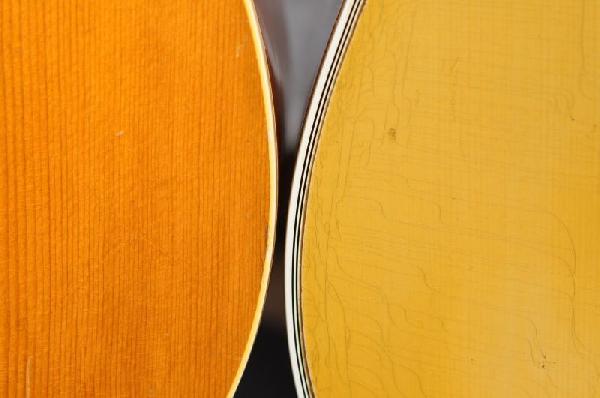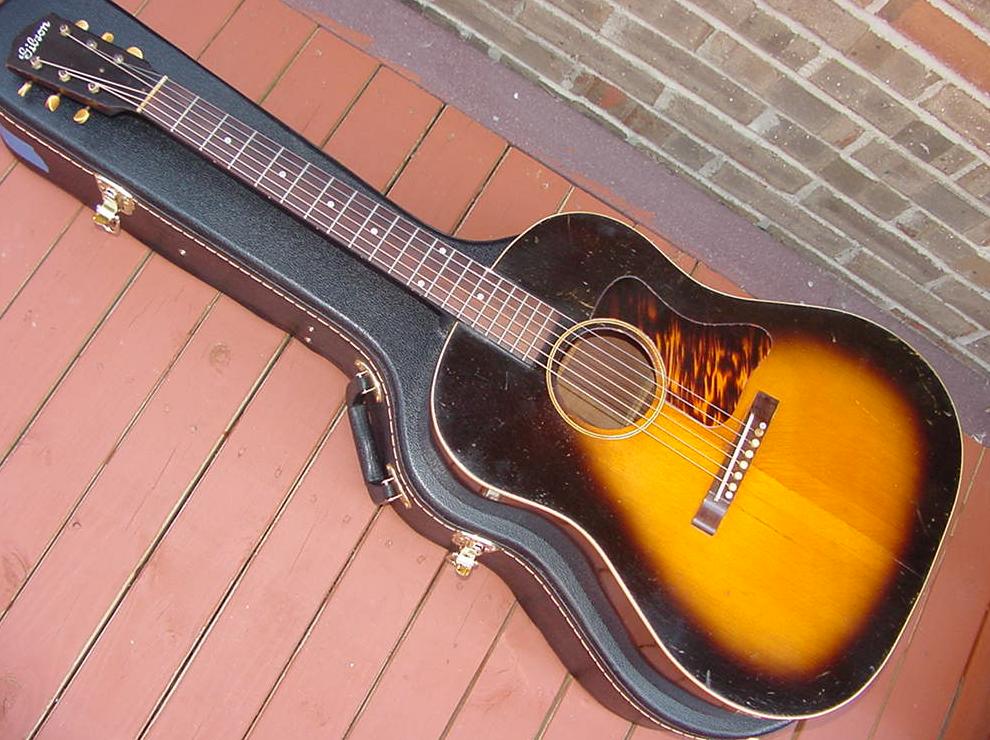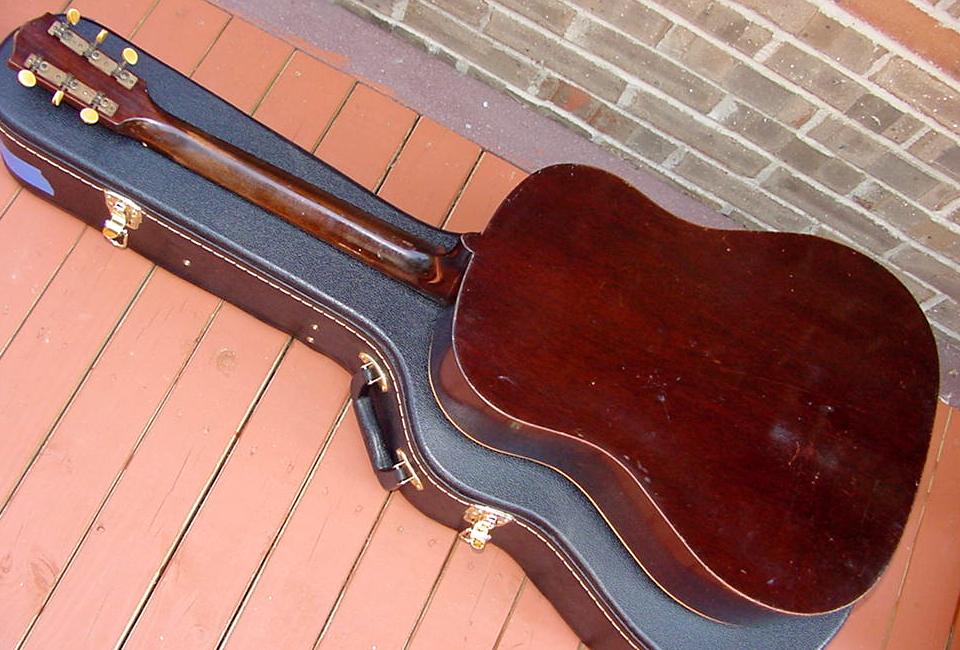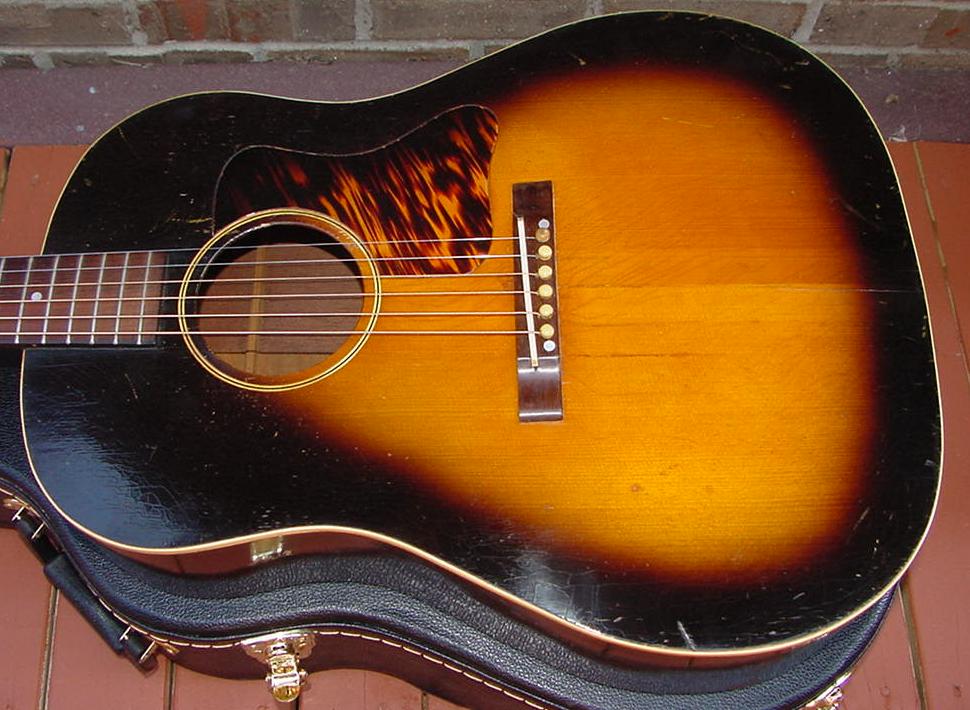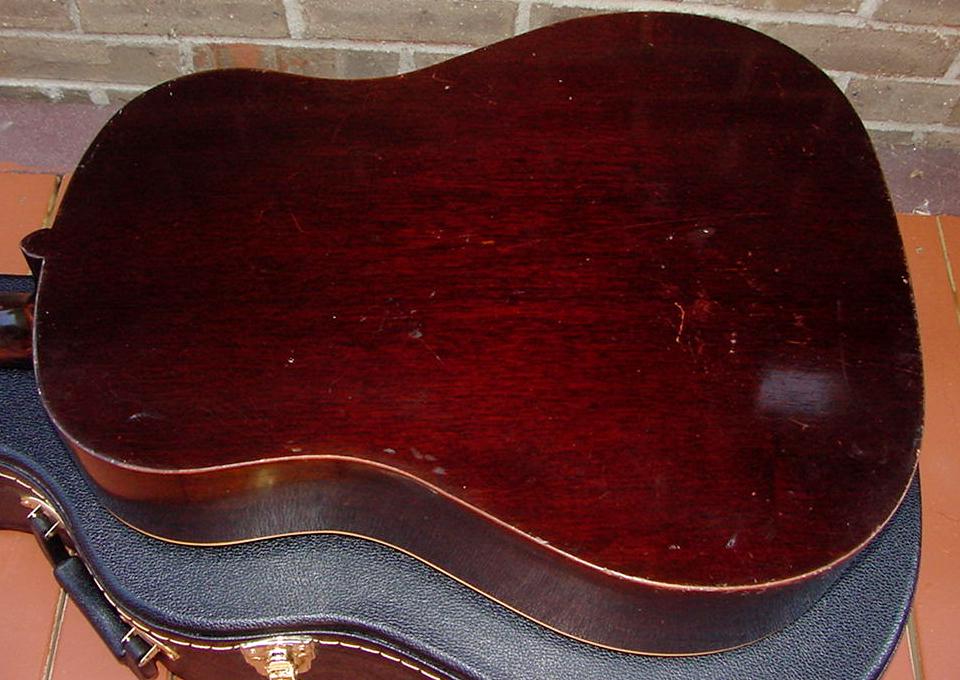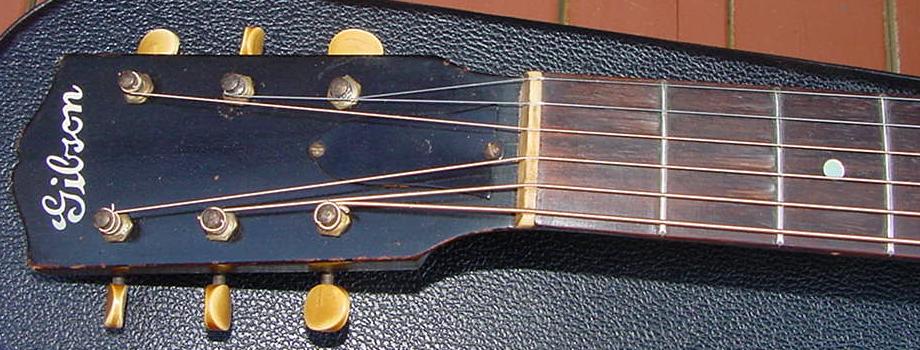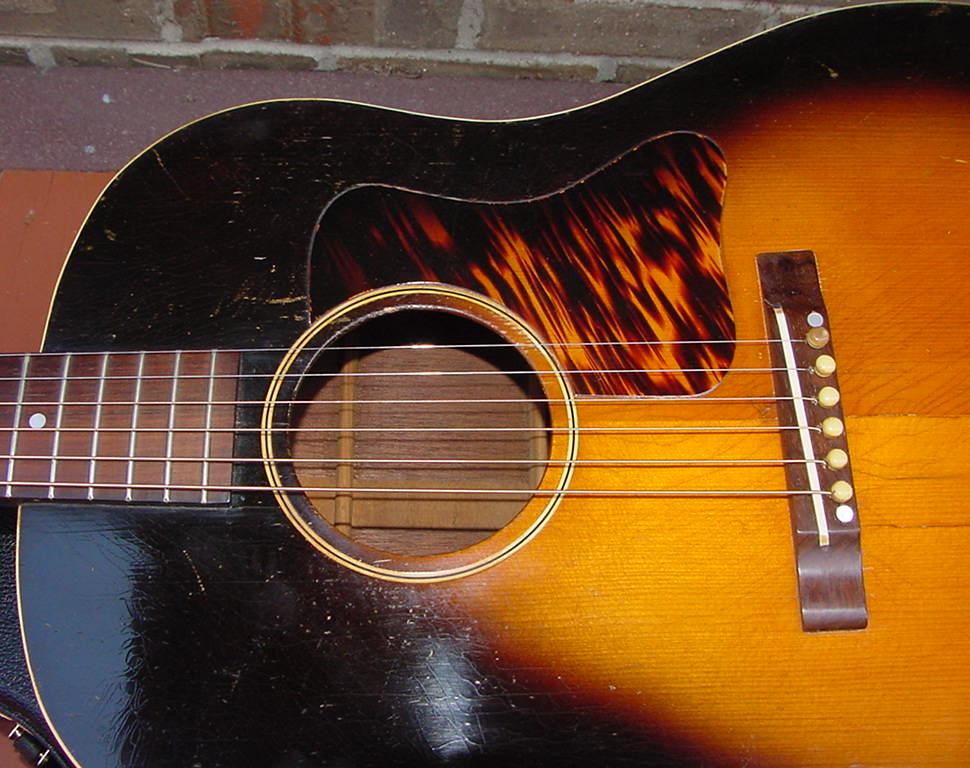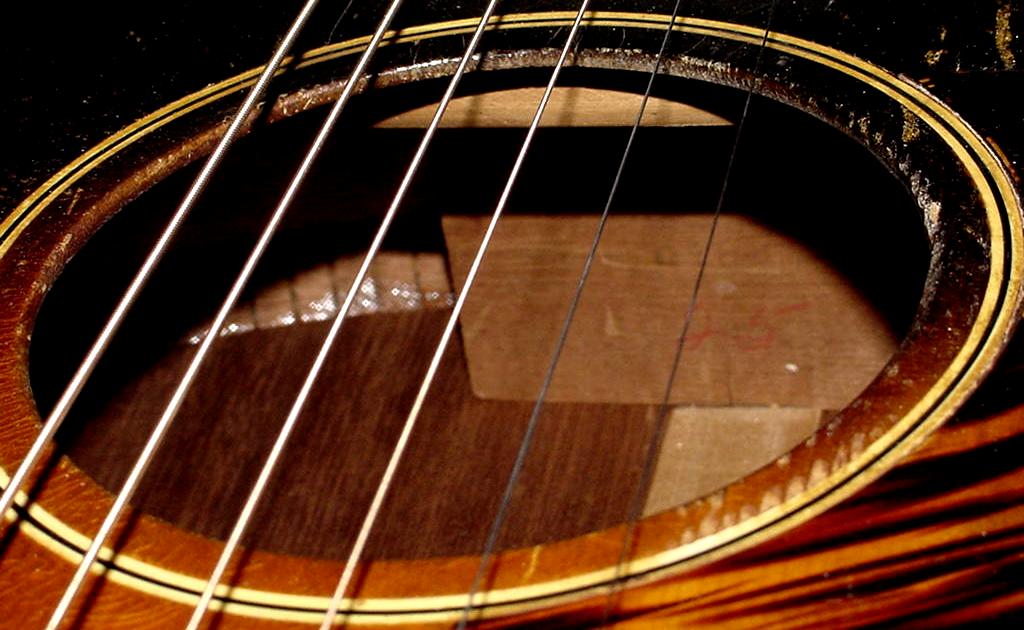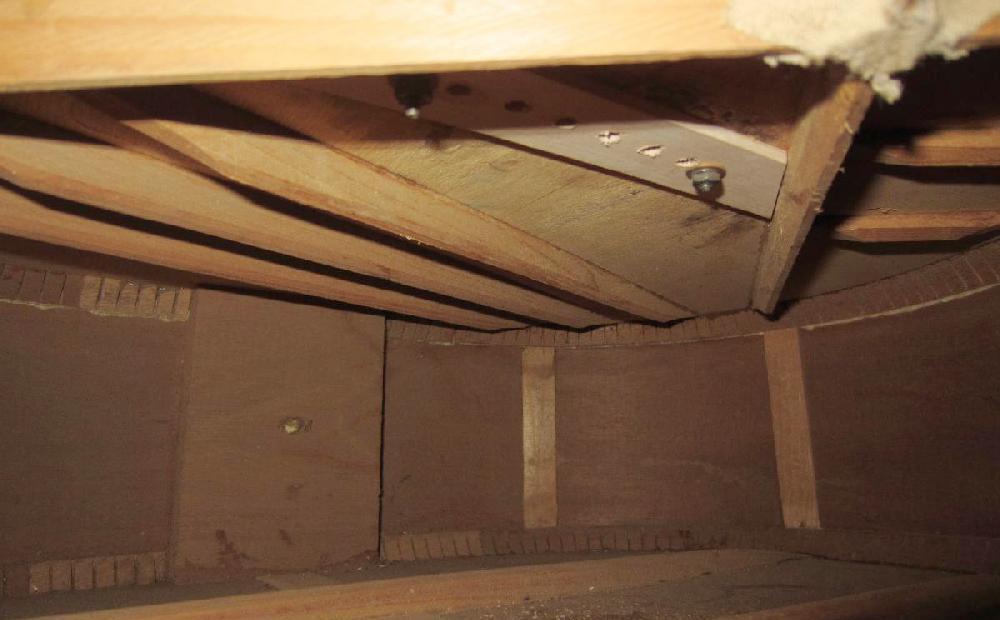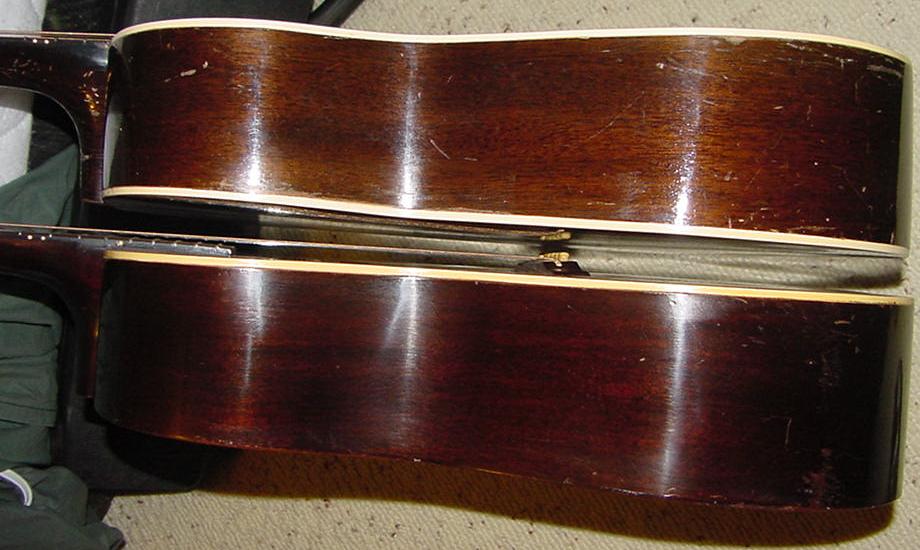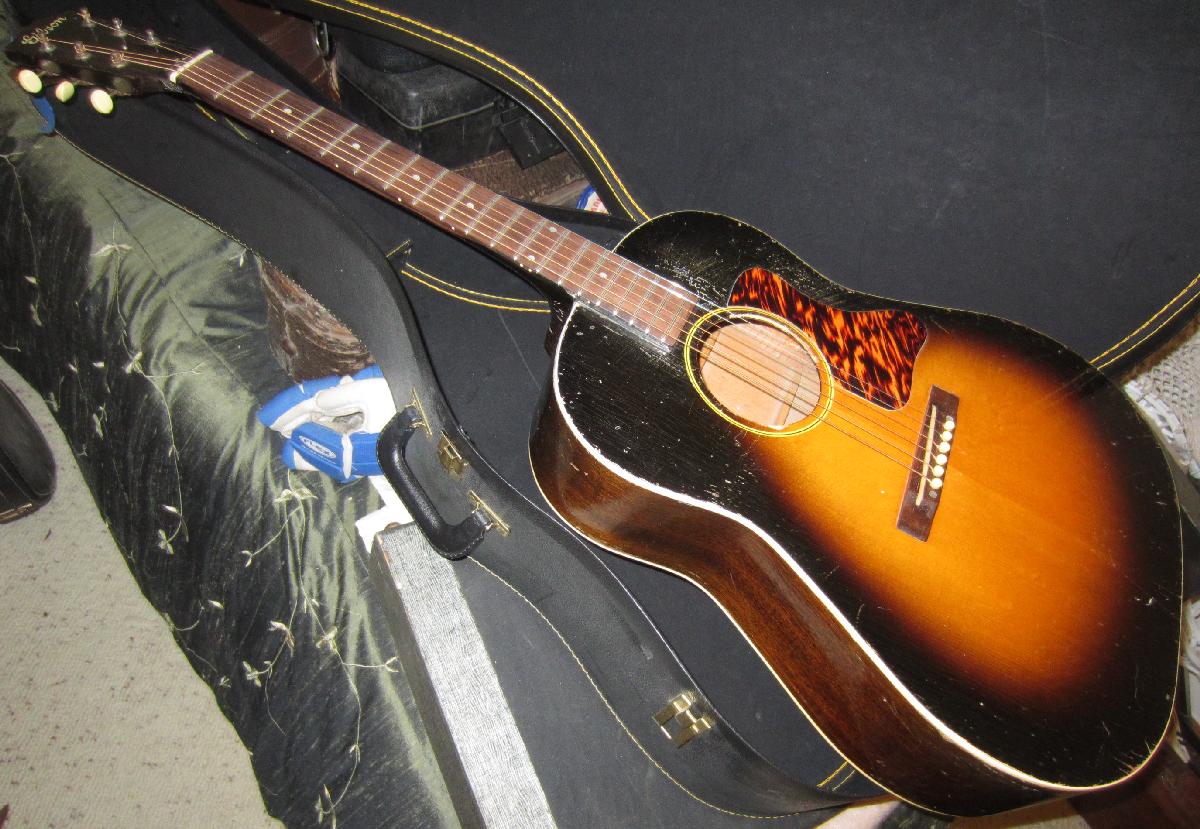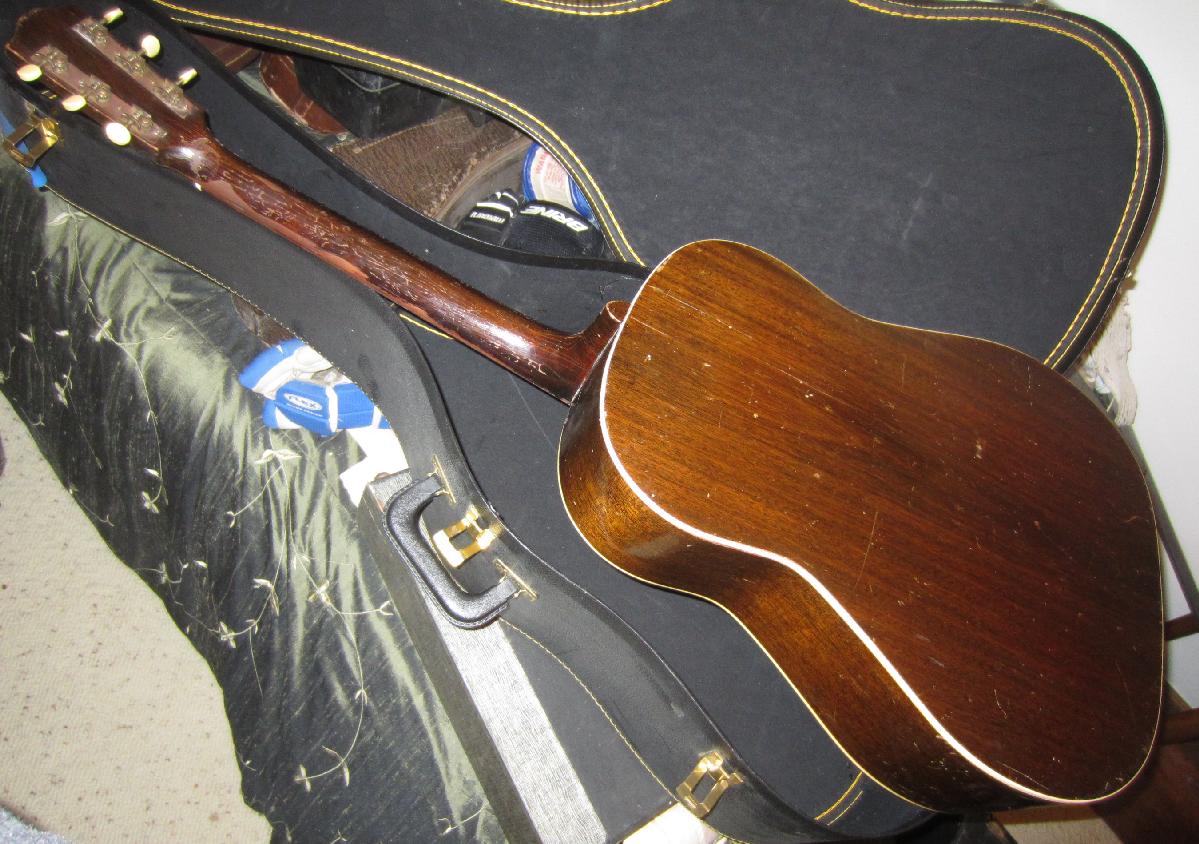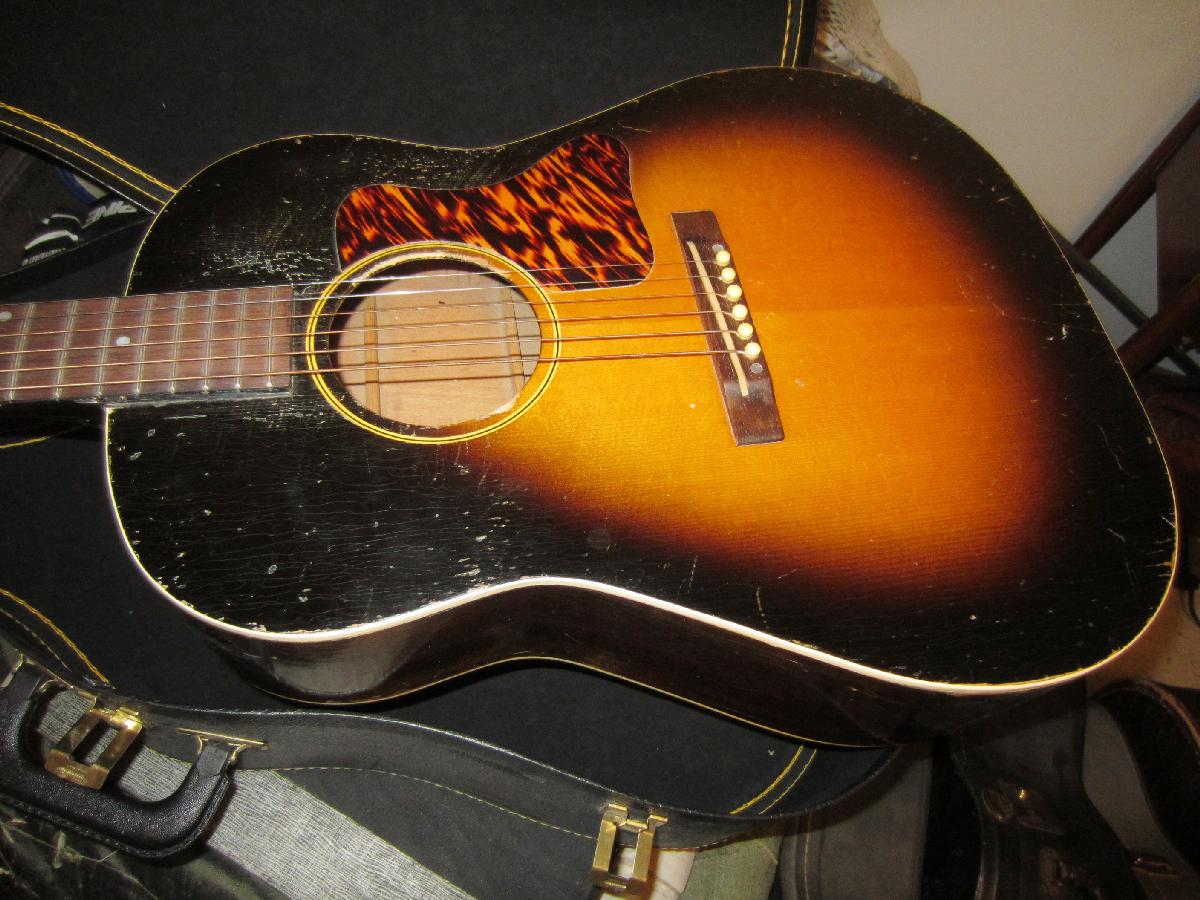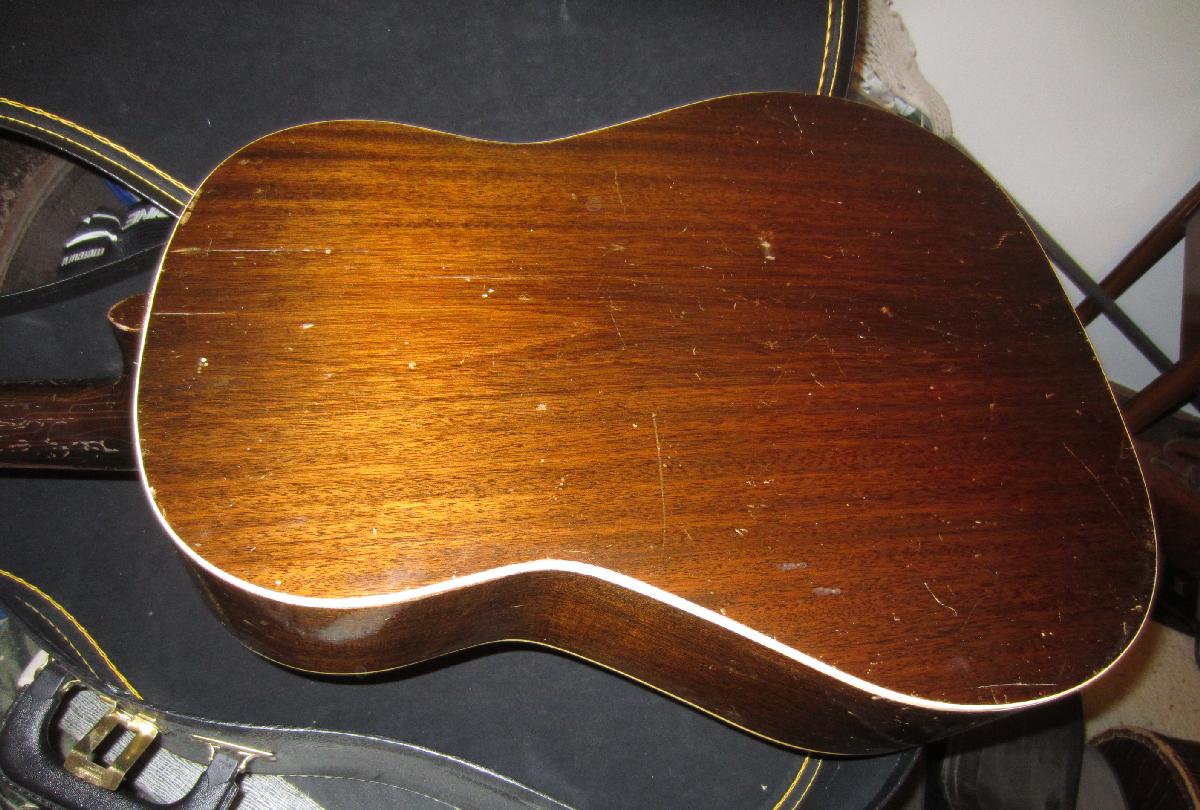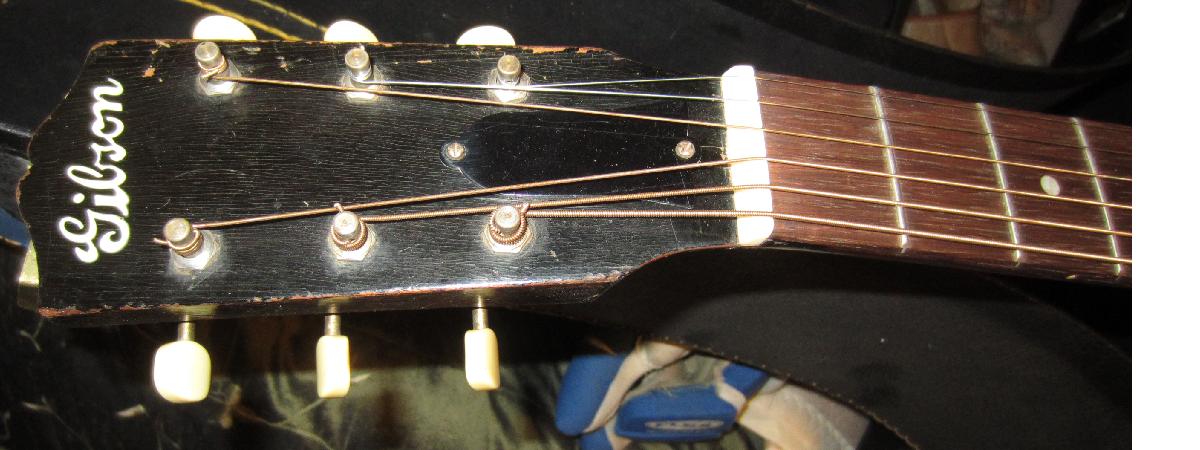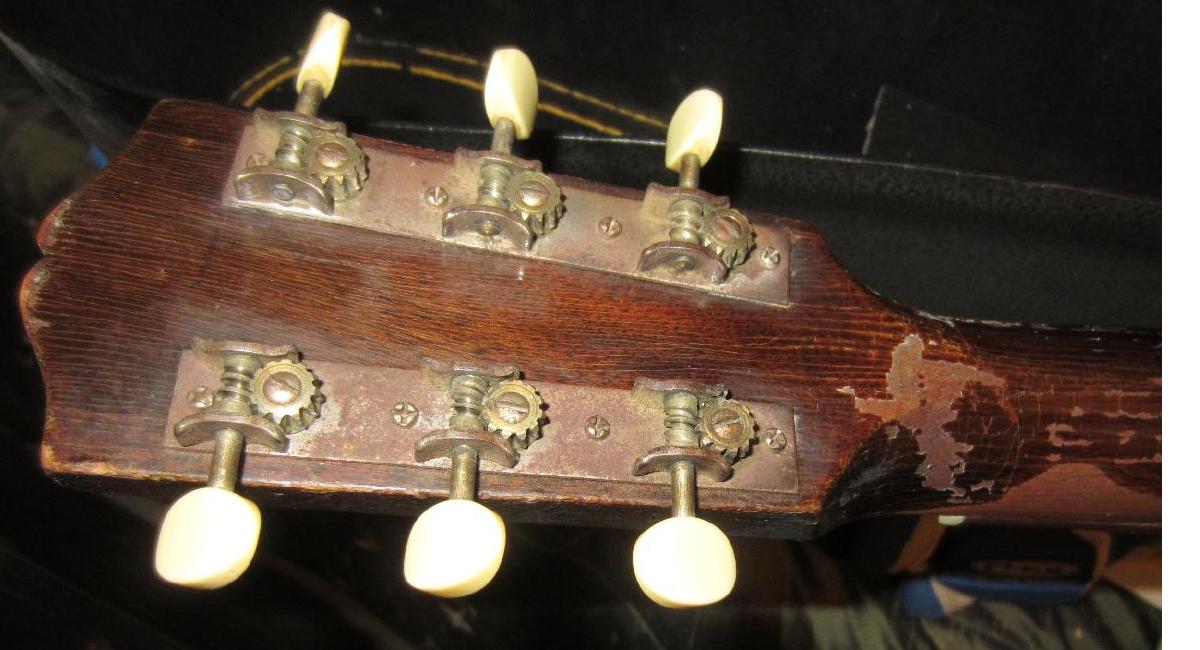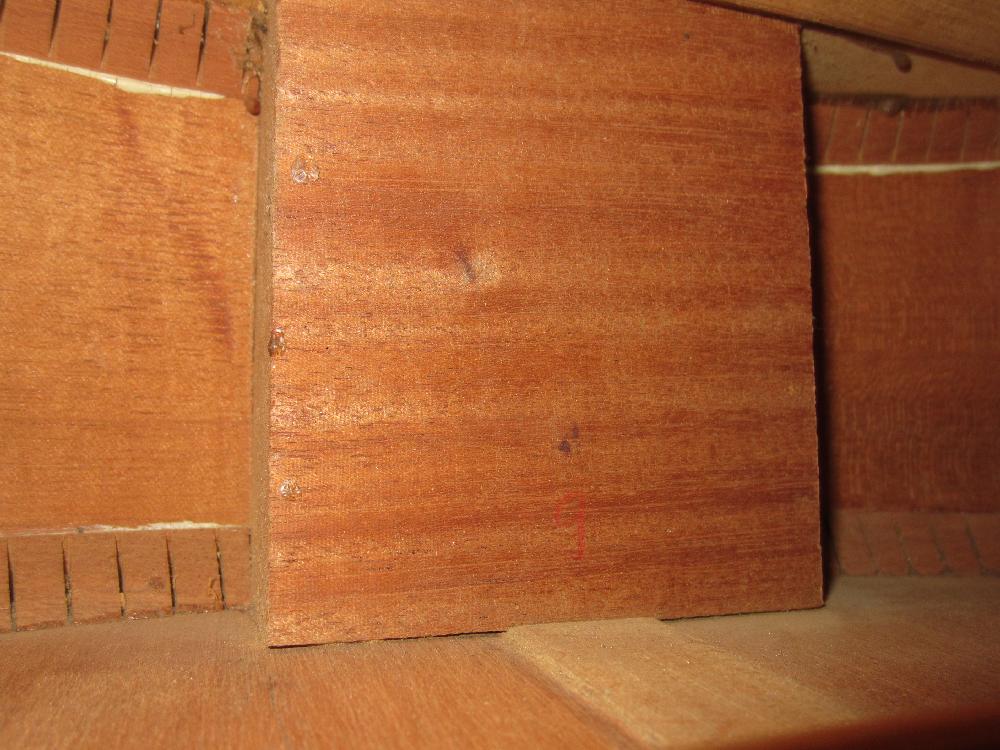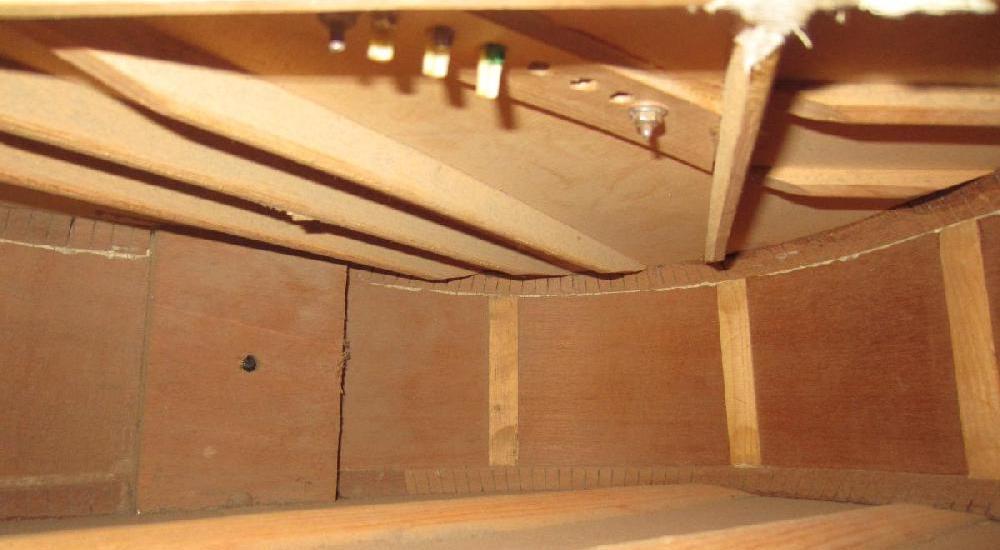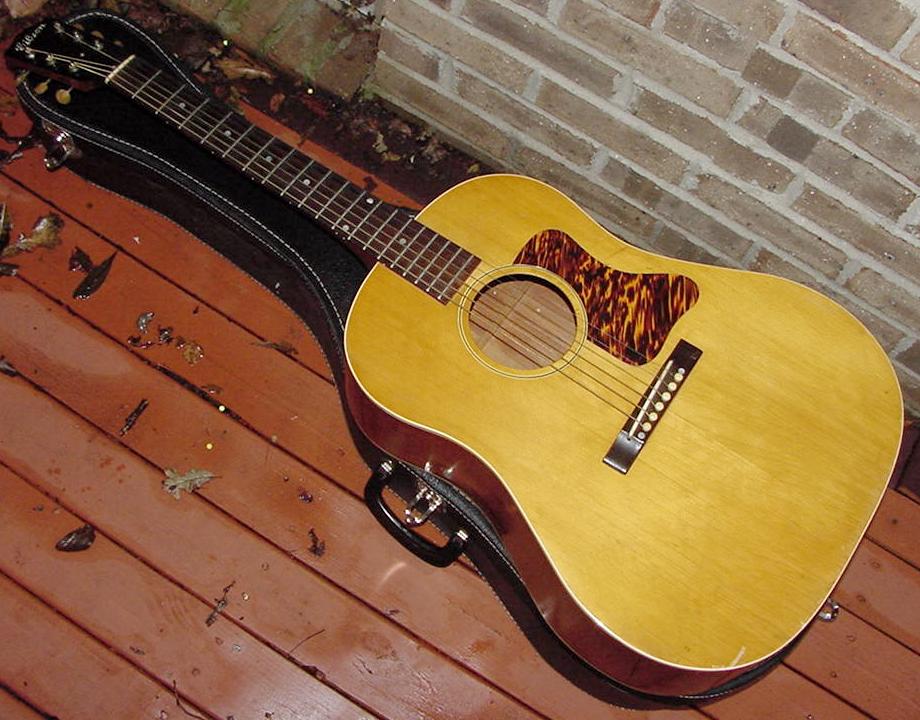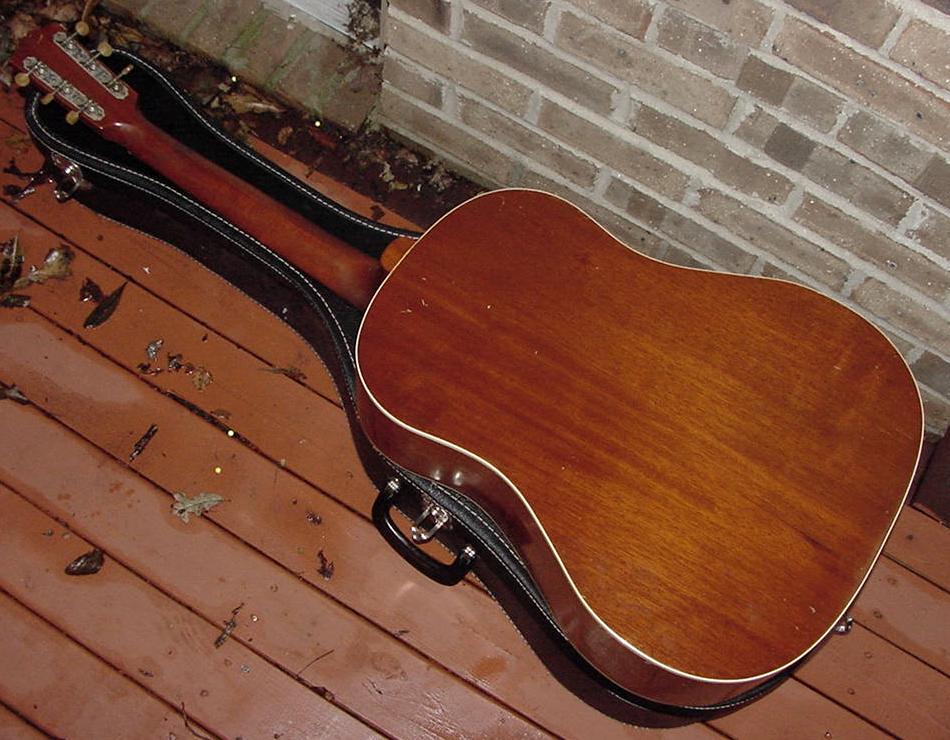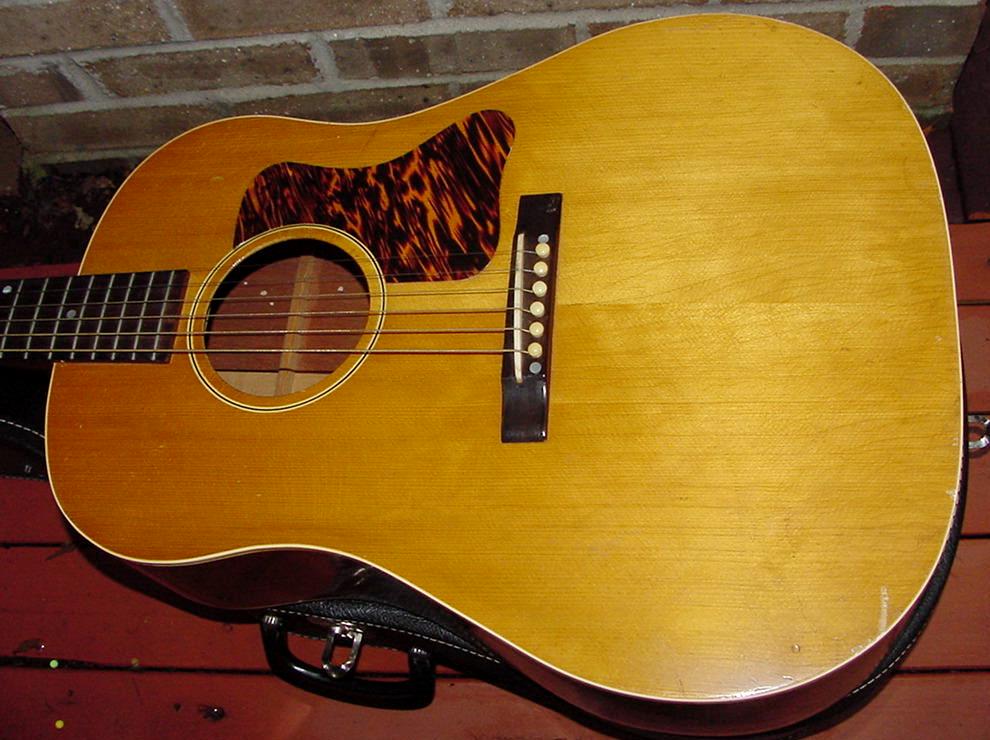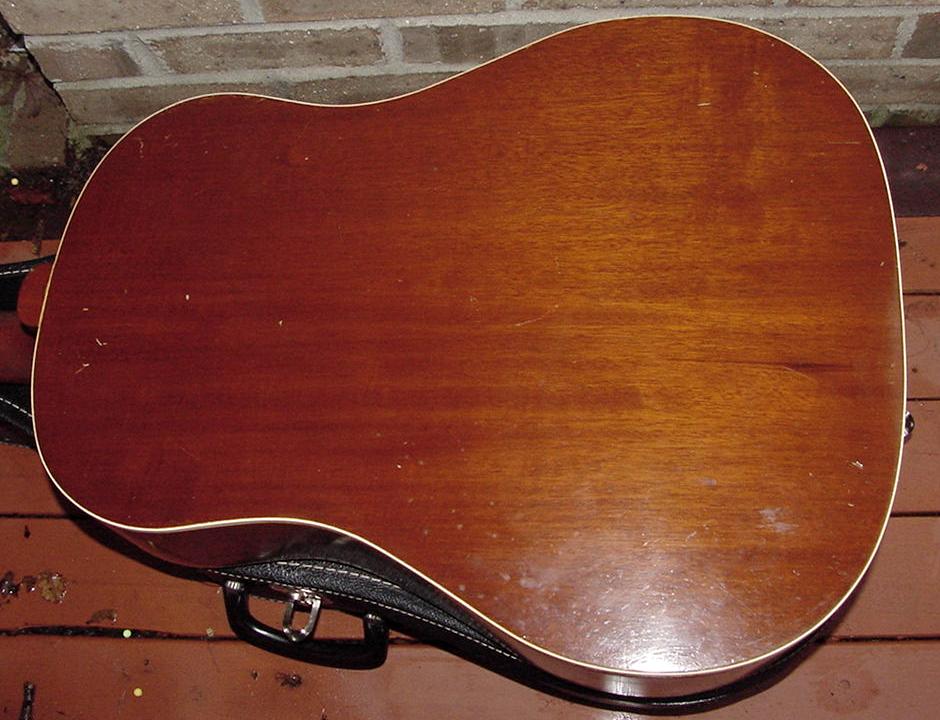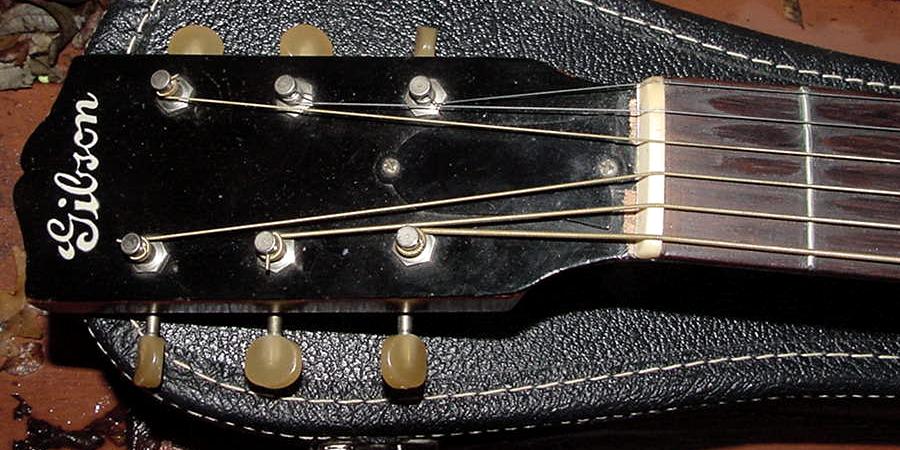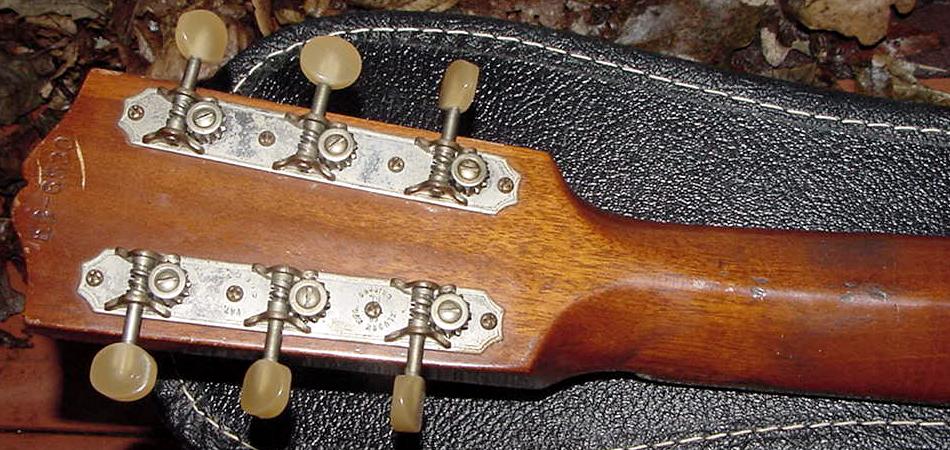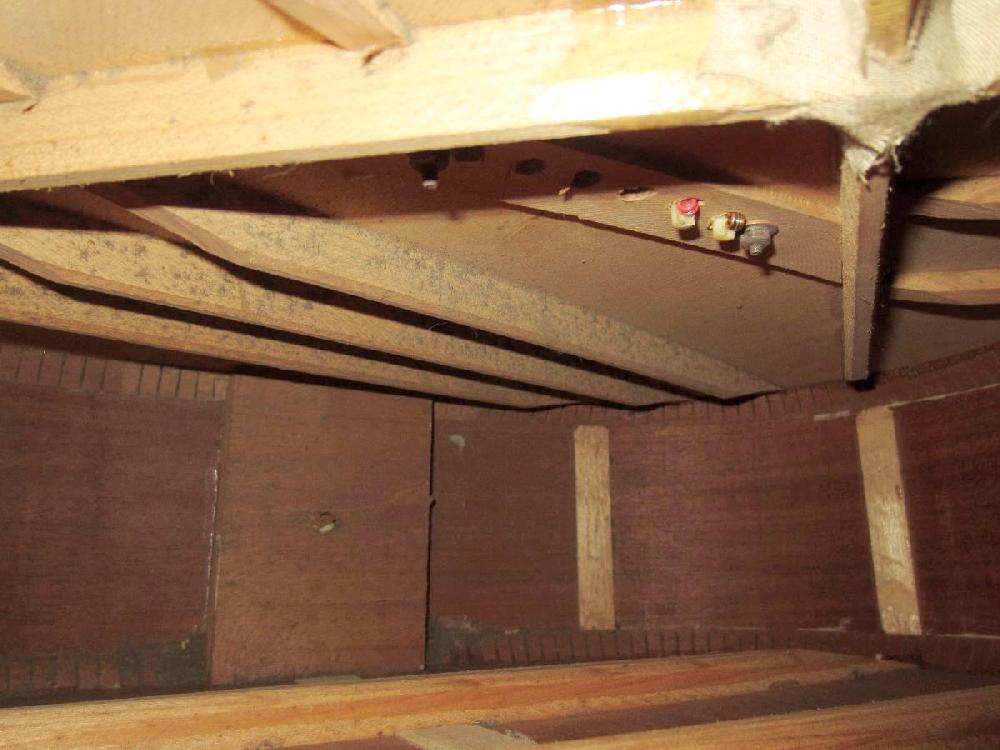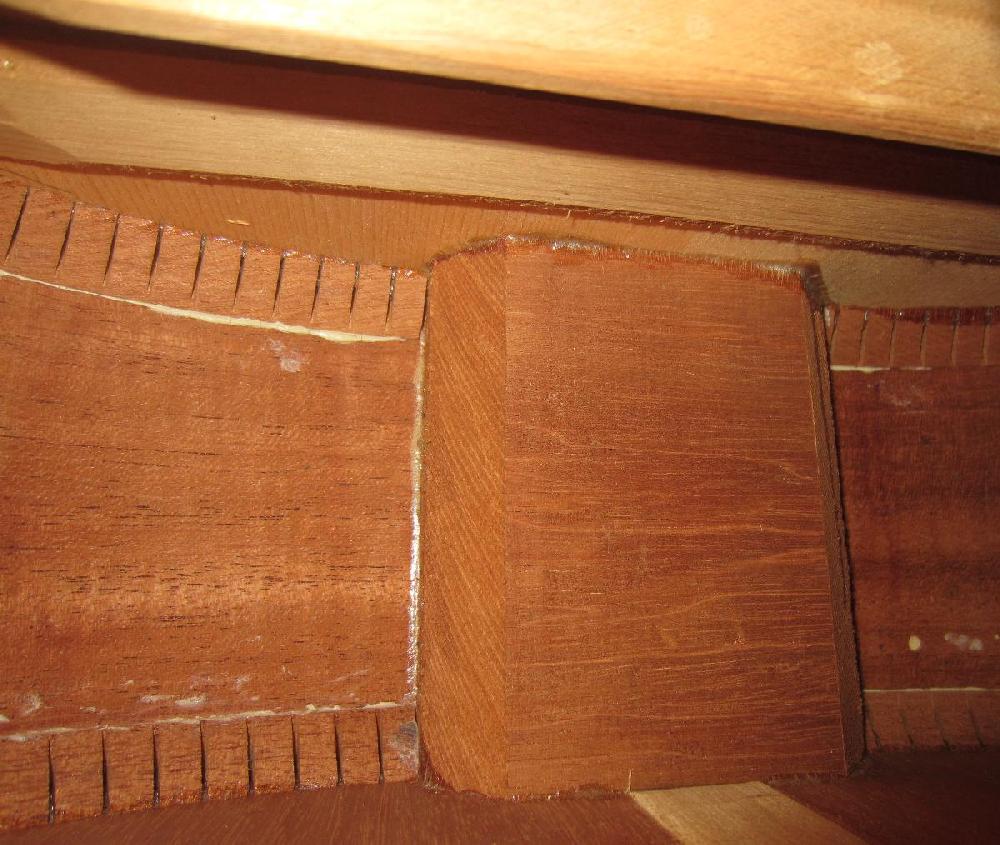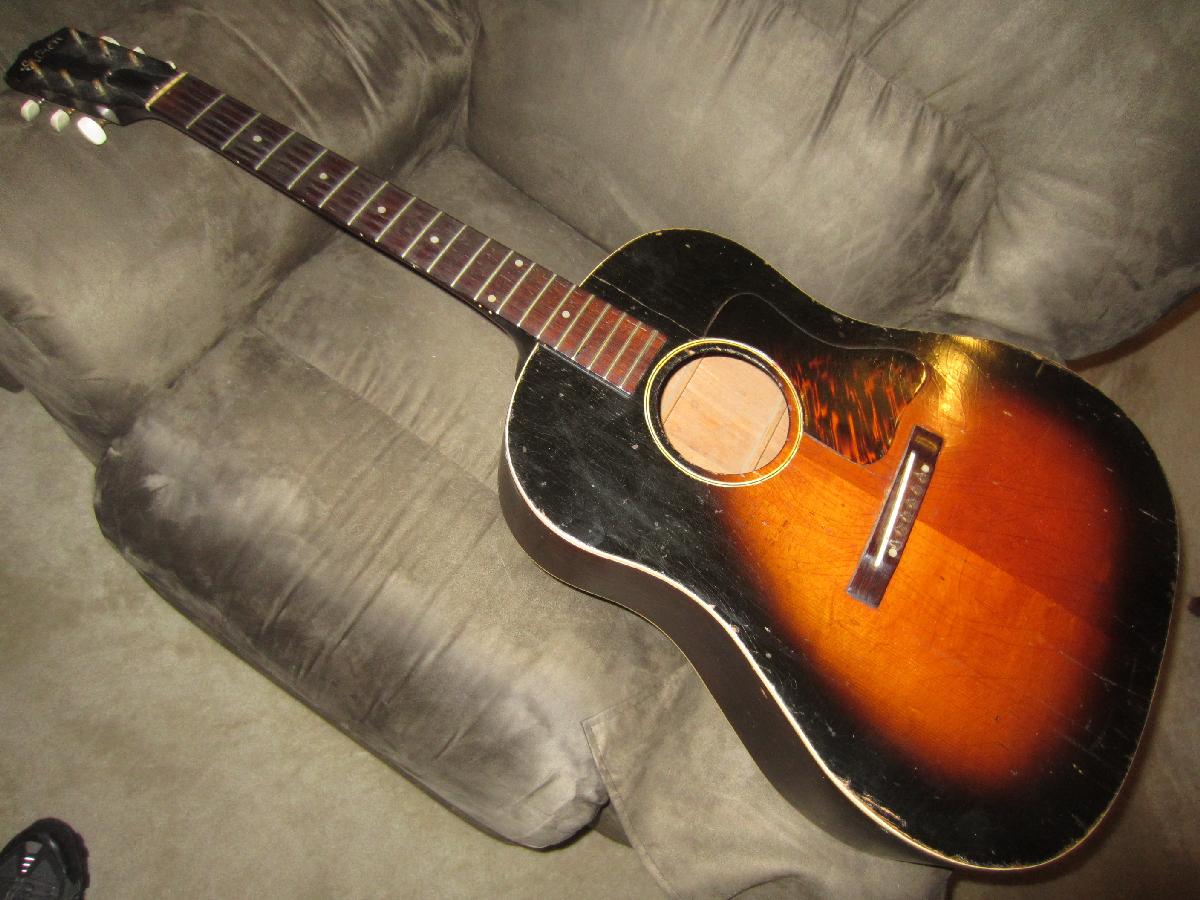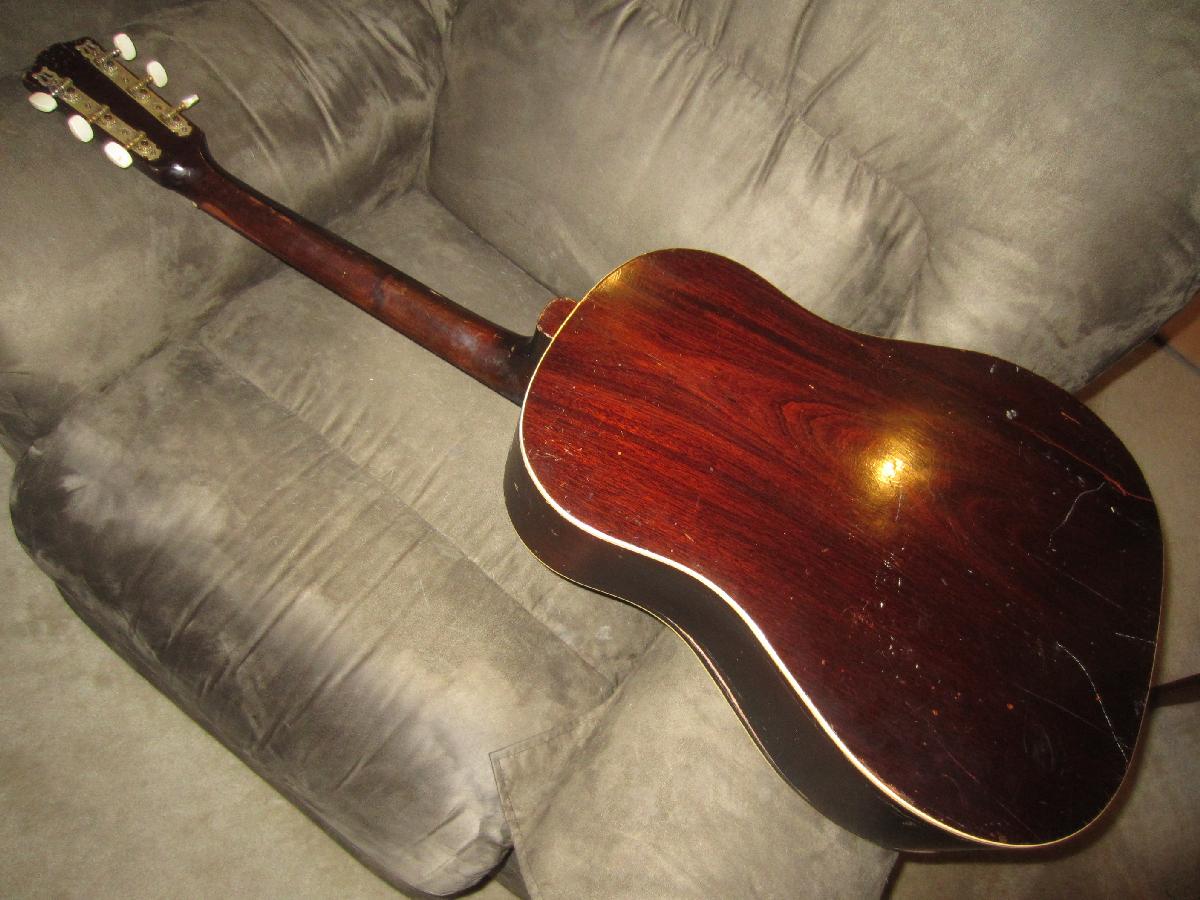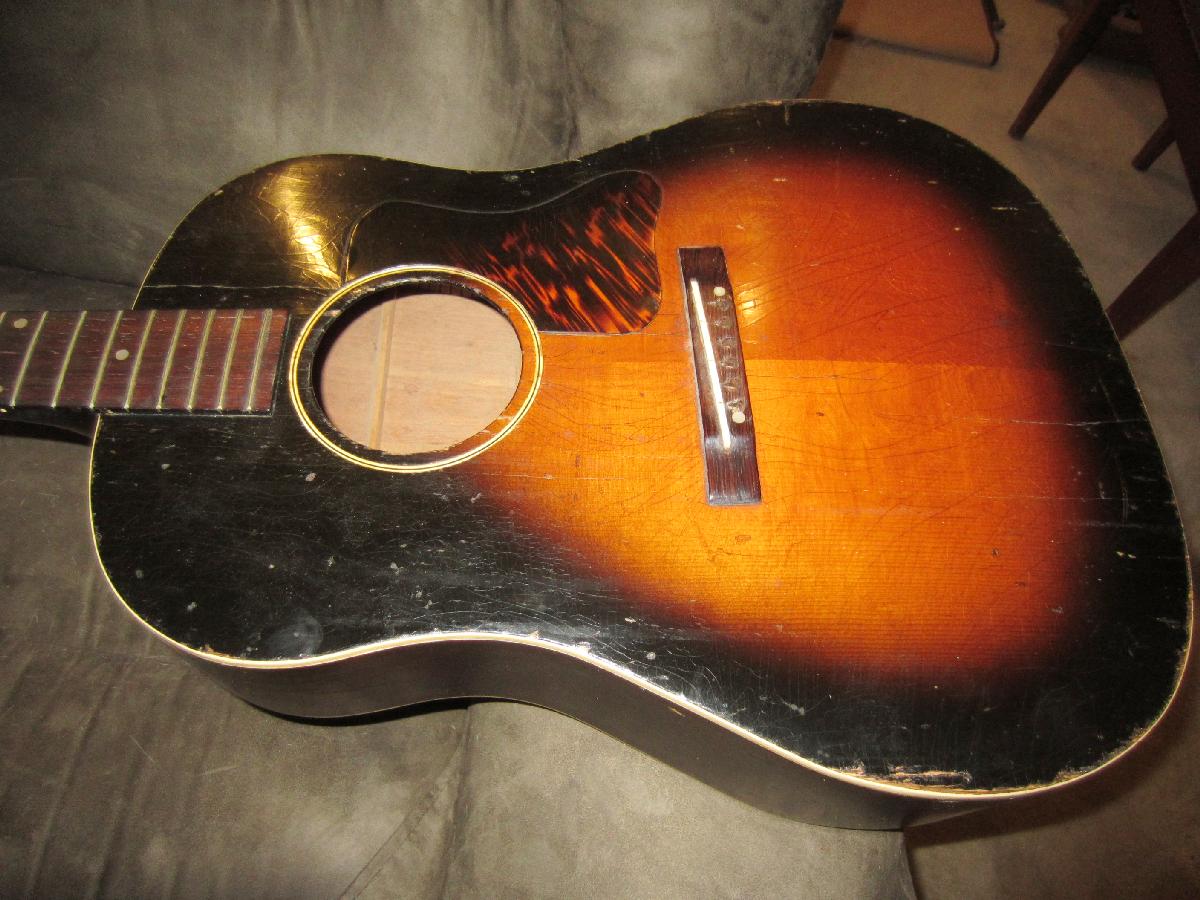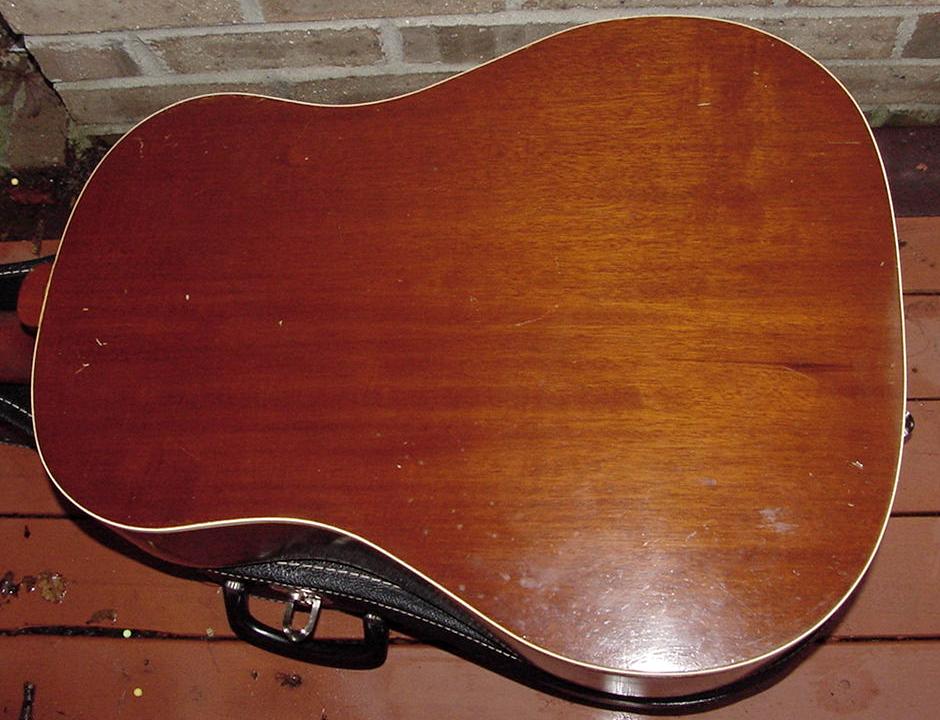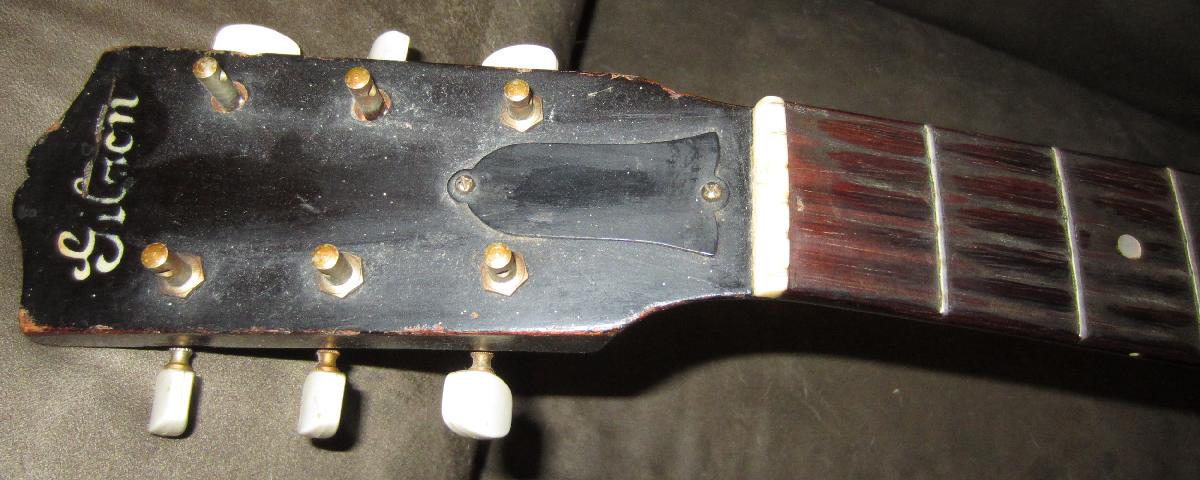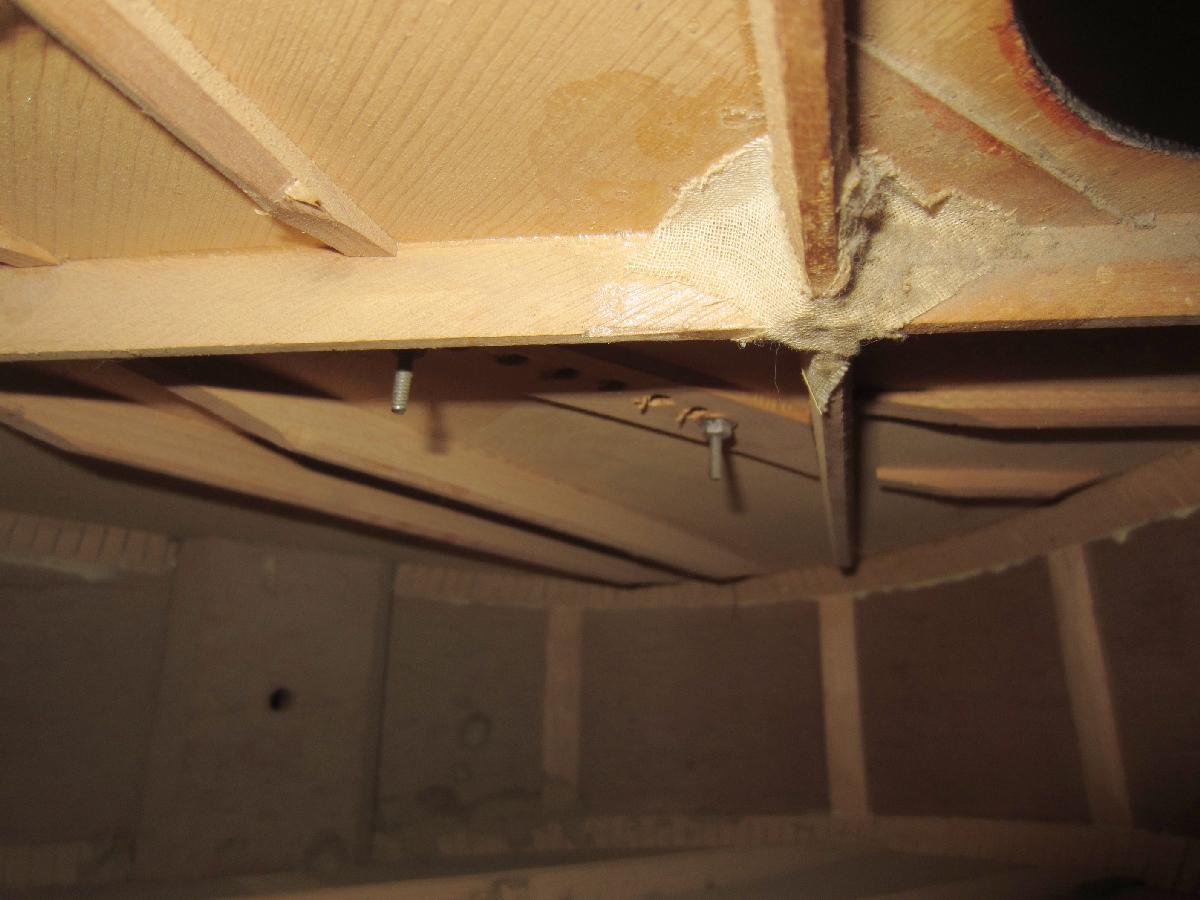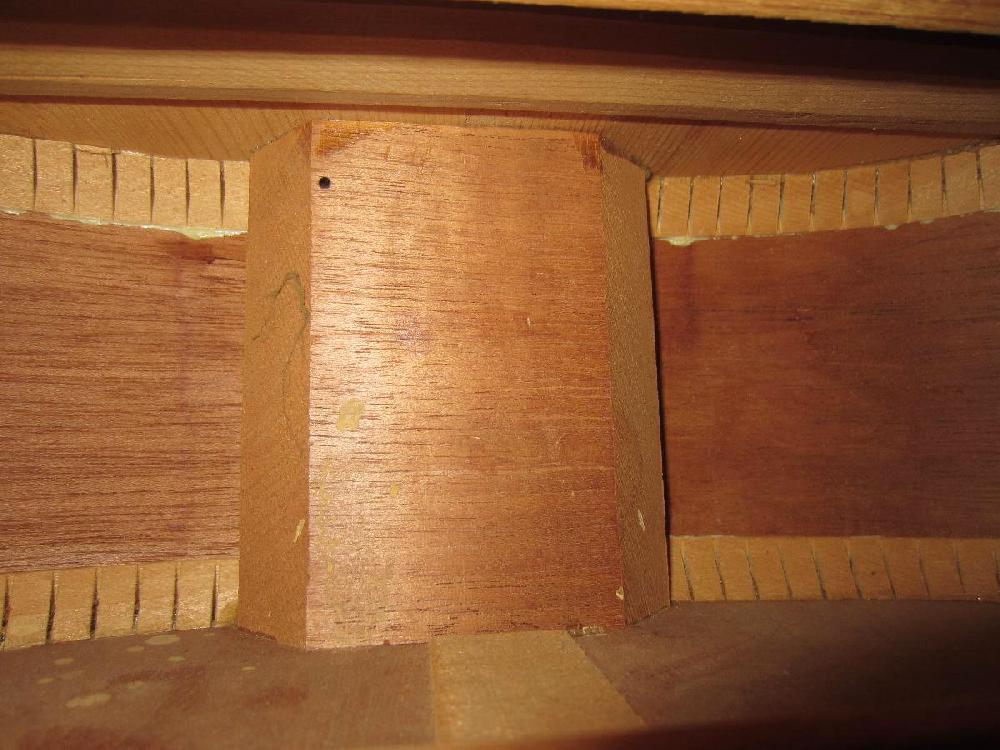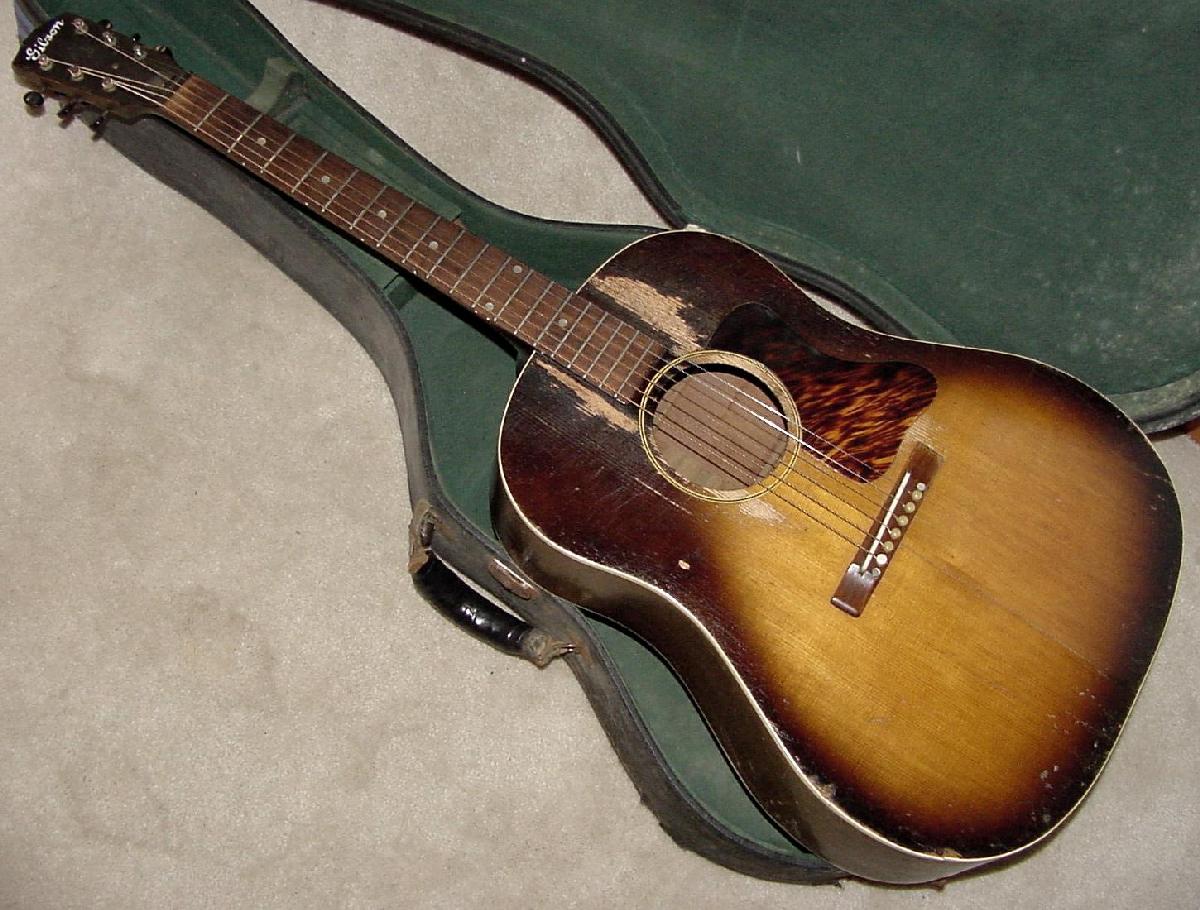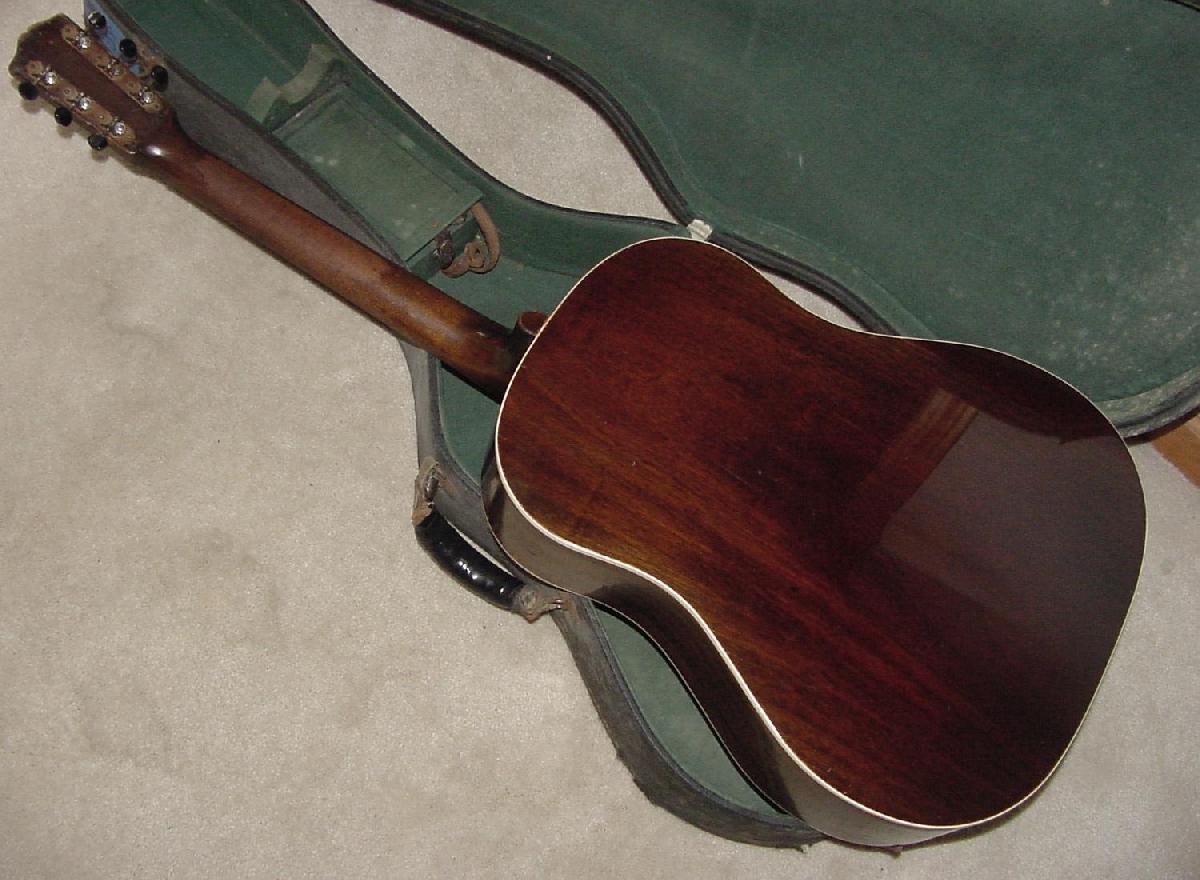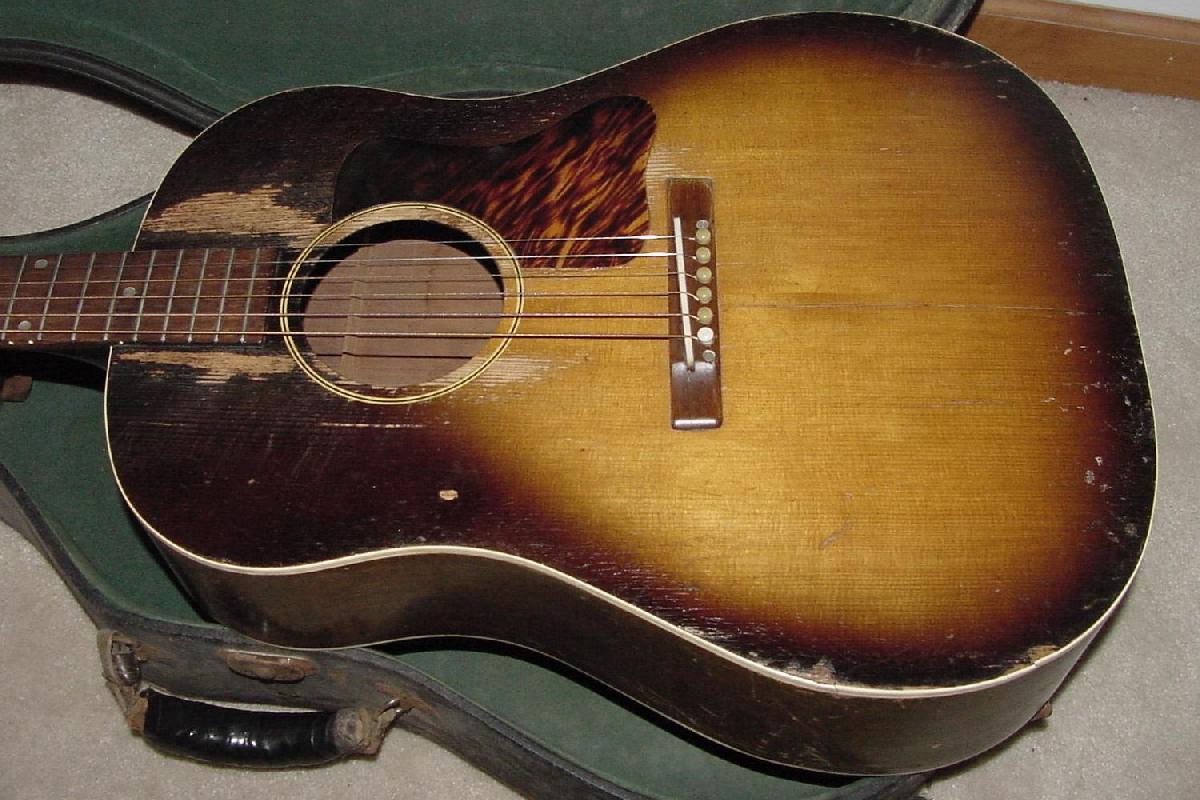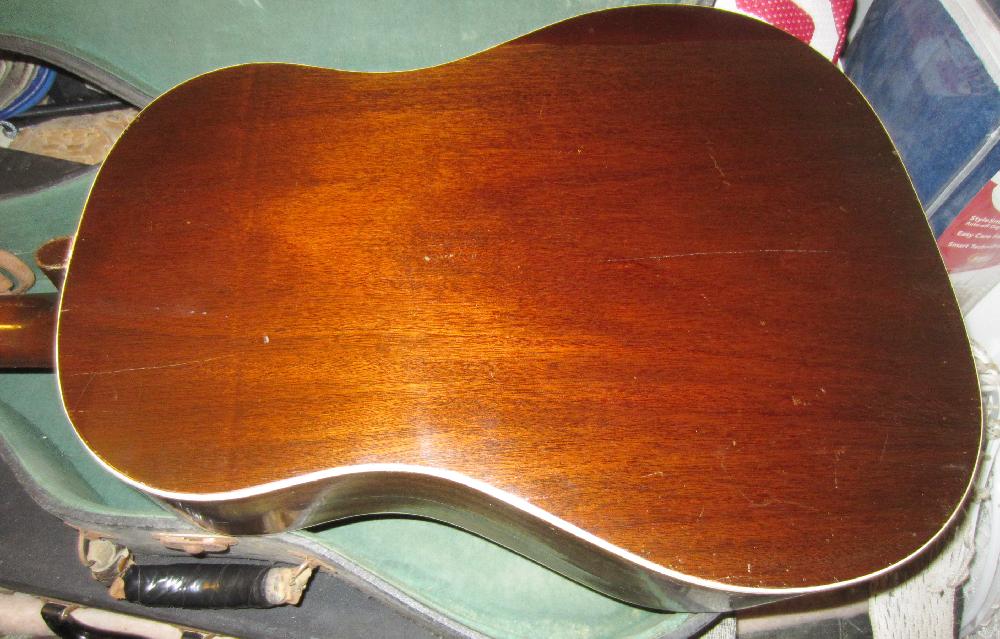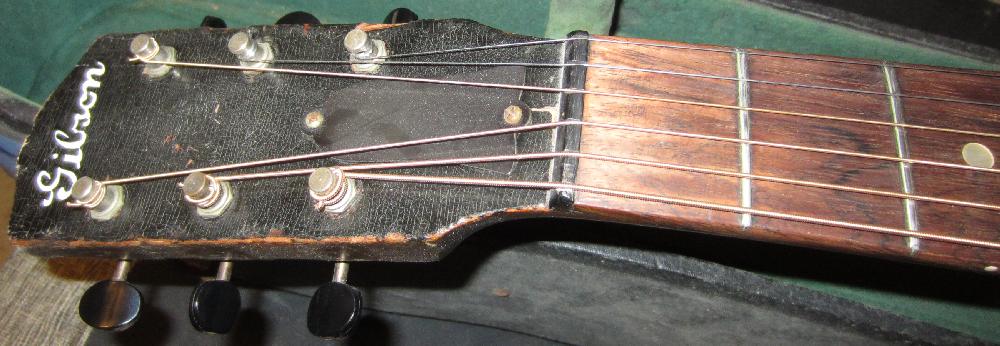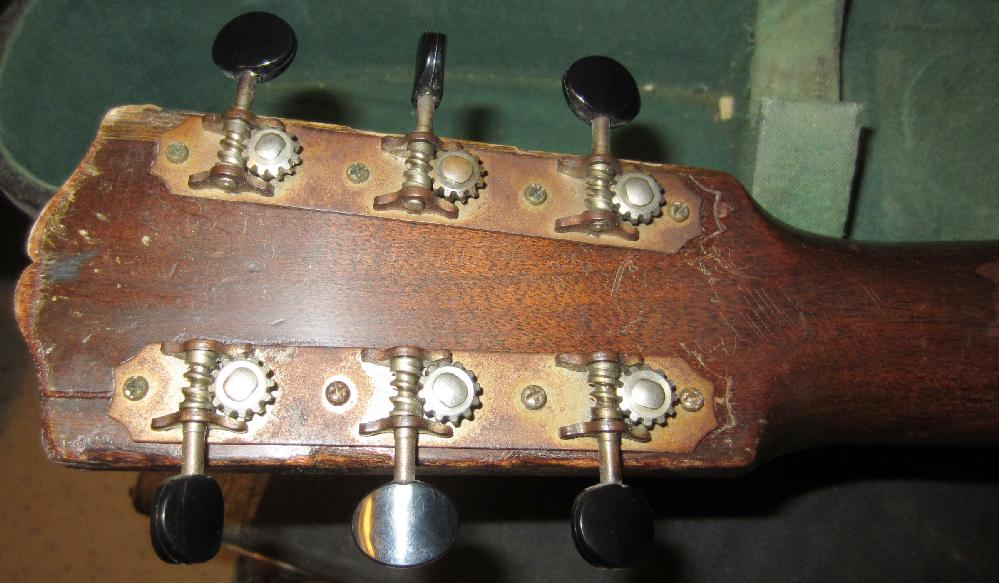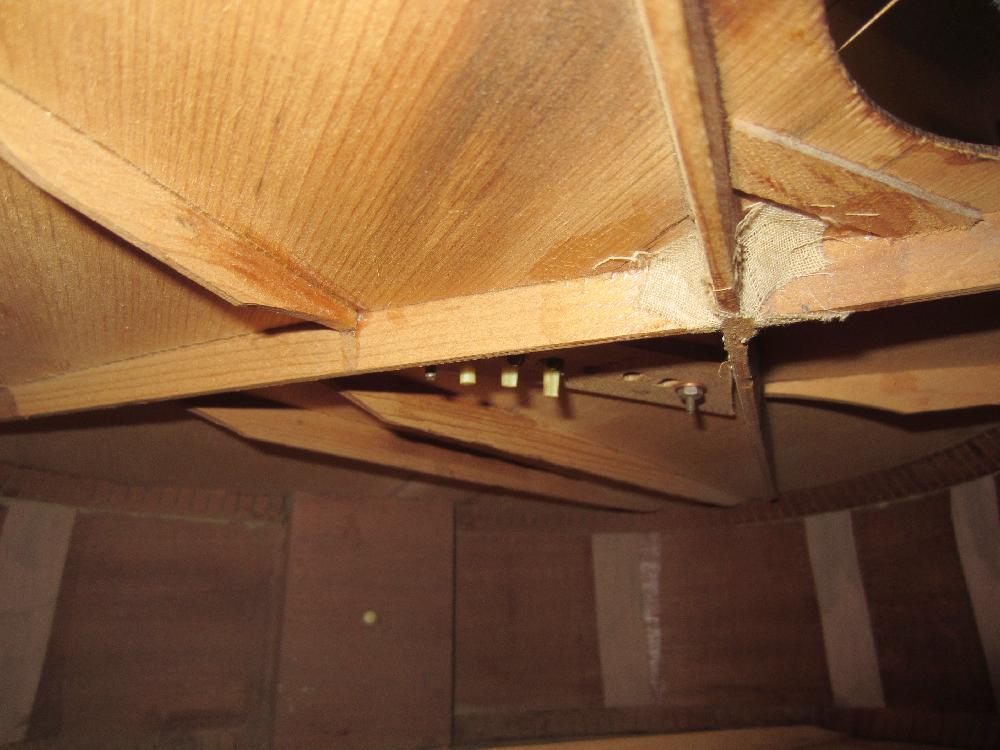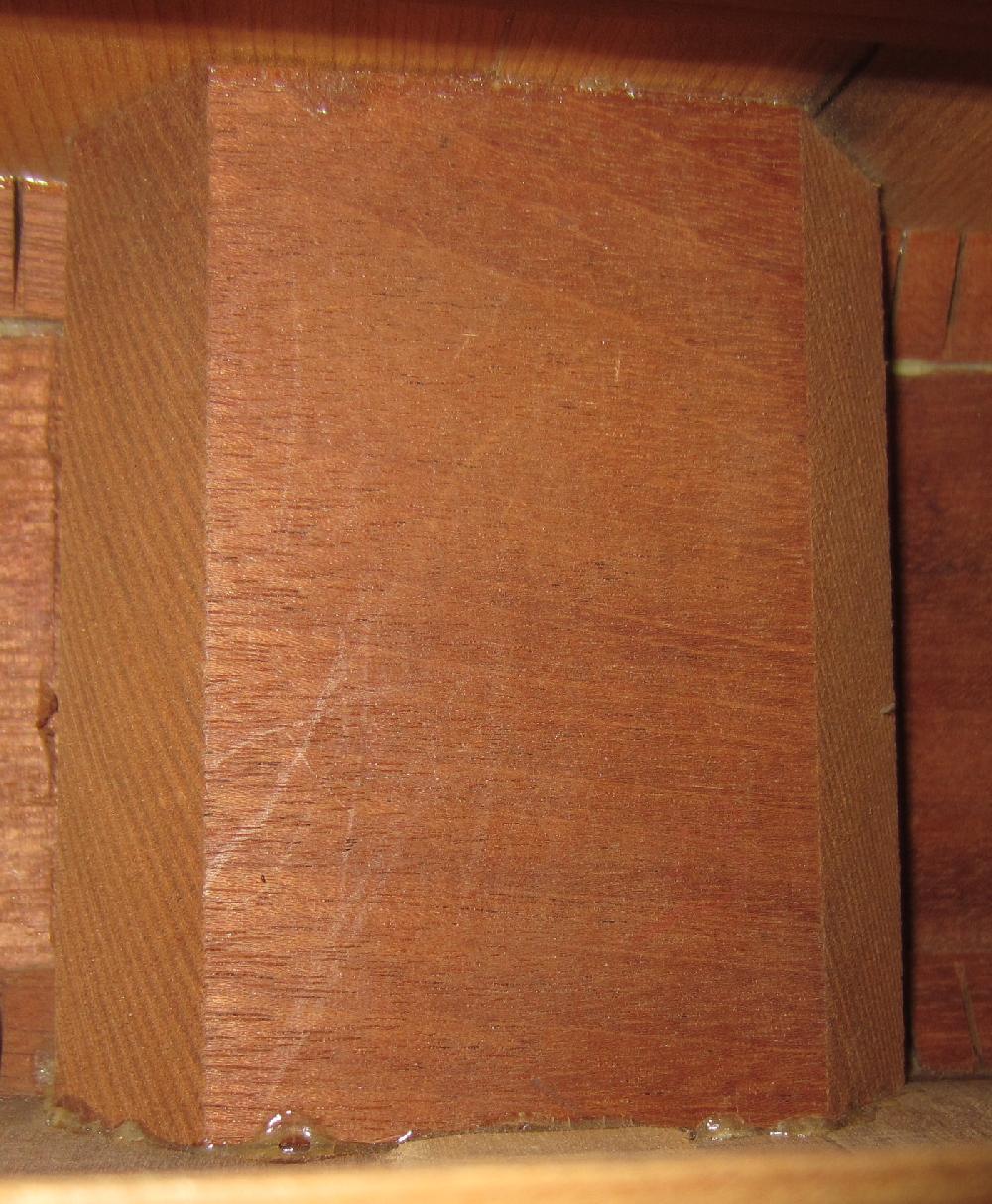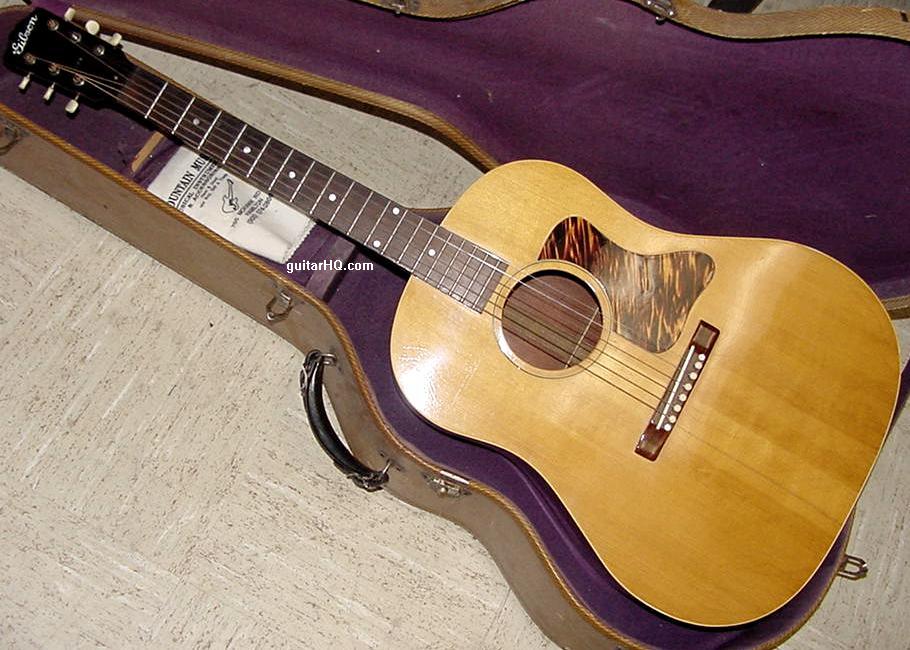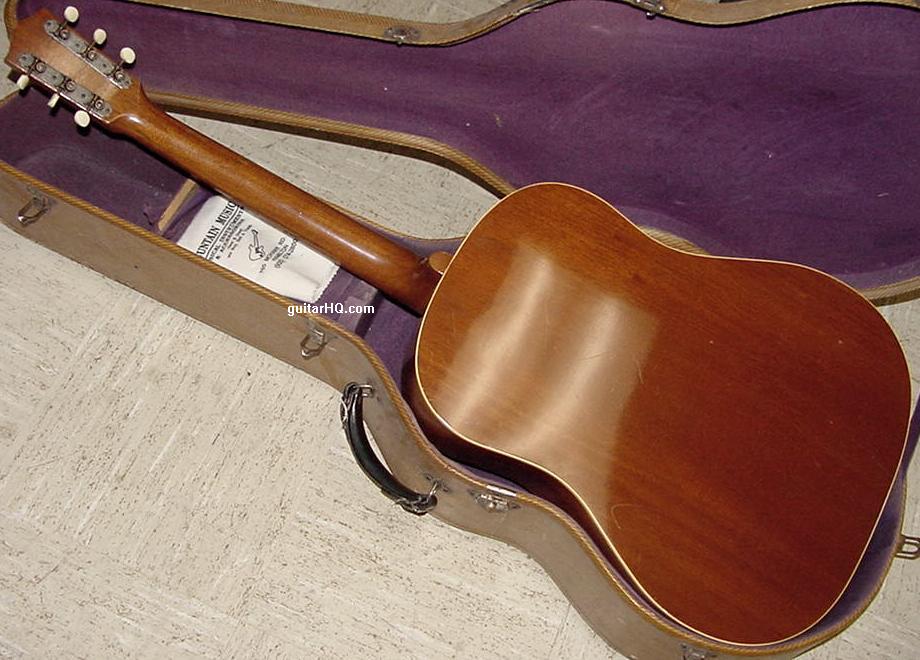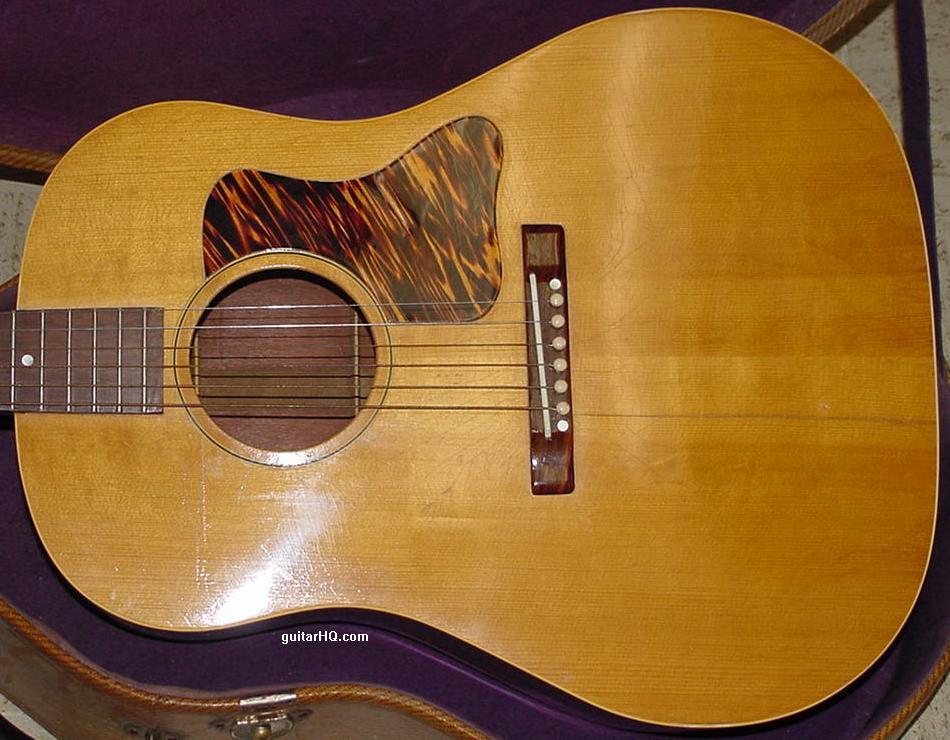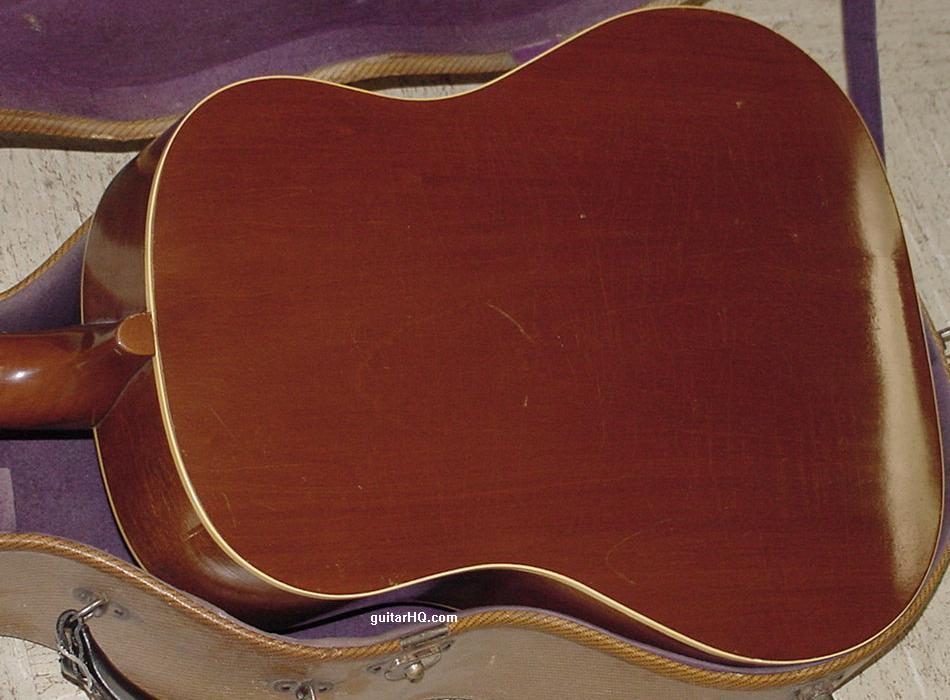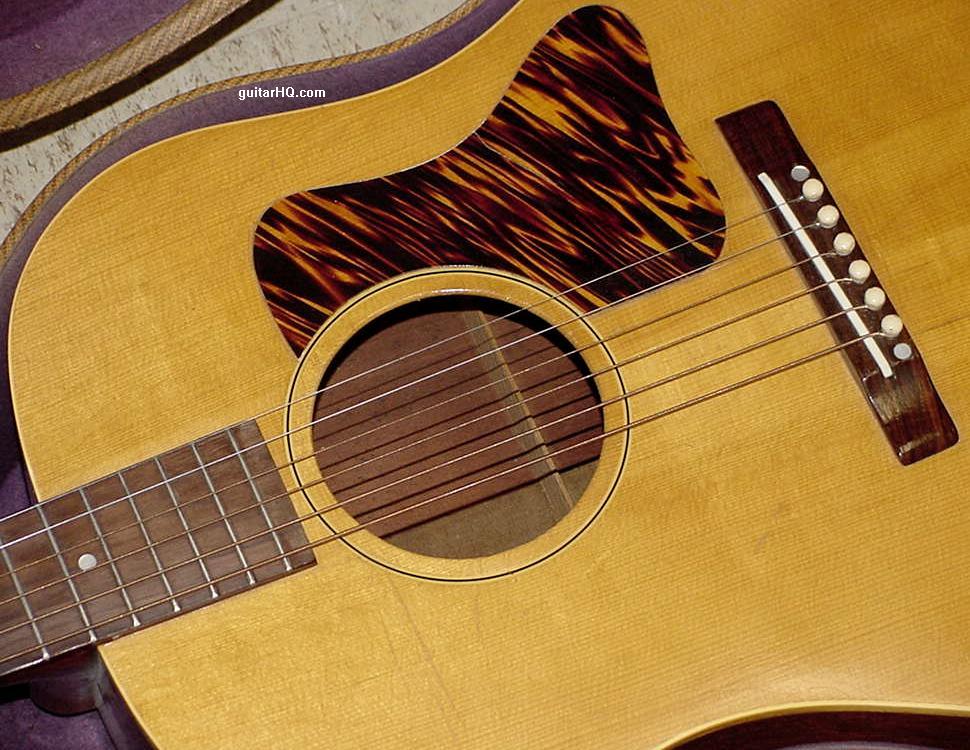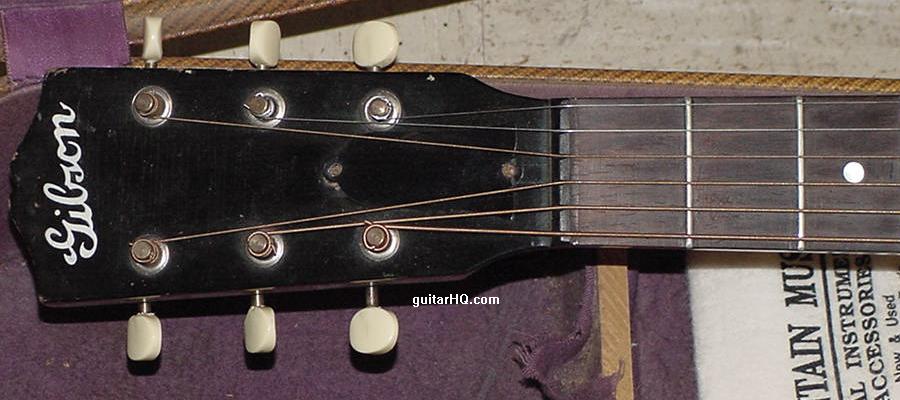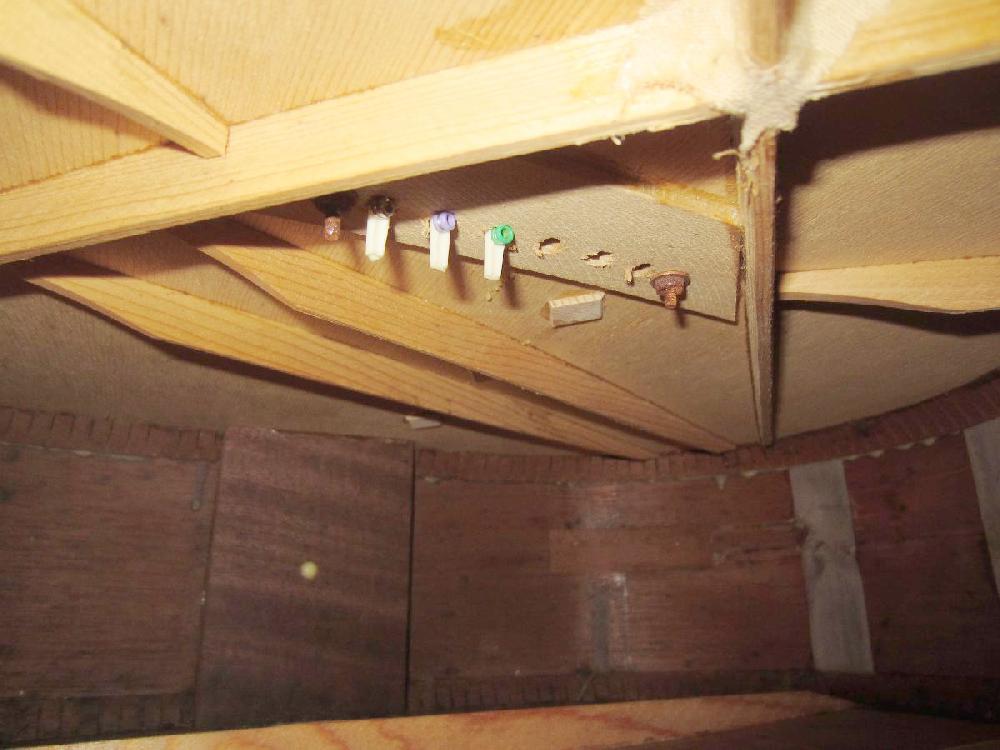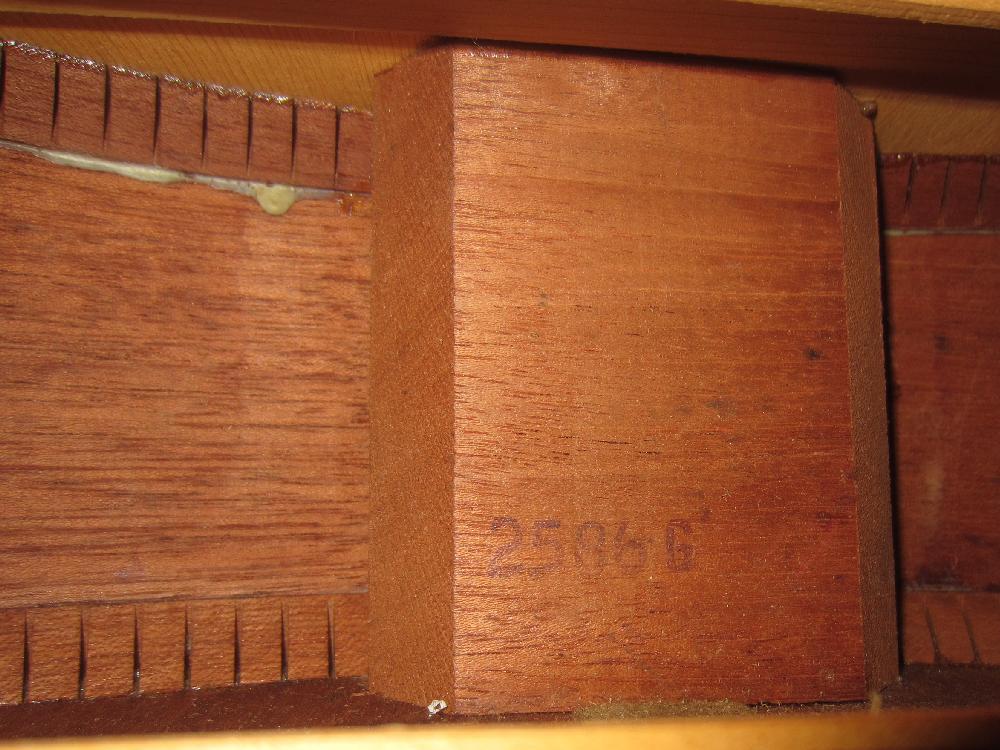Gibson Trojan Flat Top Acoustic Guitars
Description: Gibson J35 (Jumbo 35) flattop guitar
Available: 1936 to 1942.
Collectibility Rating: B+
Production: (no pre-1937 production numbers) 1938:, 1939:, 1940:, 1941:, 1942:
General Comments:
Gibson introduced this low-cost
model during the depression because the $60 Jumbo
was not selling well. The J-35 was essentially a lower
cost Jumbo model with several changes ($35 initially, though the price increased to $47.25
by 1941 for a natural finish J-35). Initially the J-35 was introduced
as a Gibson Trojan, but the name was quickly changed to J-35 (there really
very little difference between a Trojan and the J-35). These changes gave the J-35
a lower cost, but also a smoother tonal response, compared to the
Jumbo's big raw quick sound. About 3000 Jumbo 35 models were made,
more than any other pre-WW2 Gibson flat top. The J-35 was also made
in about three different bracing variations: three
non-scaloped braces (1936-1939), two tone bars with
non-scaloped braces (1939-1941), and two tone bars scaloped (1941-1942).
The tone bars are glued to the underside of the top, behind the bridge, running at an angle
across the top's "hips" (widest point across the top) from the treble
leg of the "X" to the side. (See picture below.)
The Gibson J-35 in all forms is a very nice model, and if
you have one for sale please contact me.
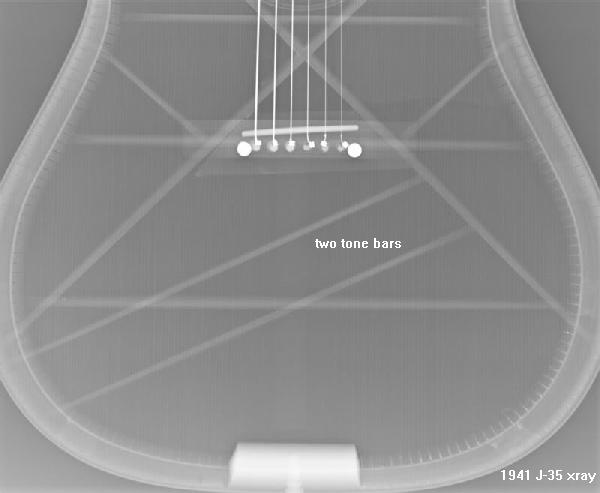
If you need to figure out the exact year of your Gibson J-35 Jumbo, use the FON (Factory Order Number). This is located inside the body's sound hole on the neck block. See the Gibson Serial Number Info web page for help determining the exact year.
Using J.Spann's book on Gibson FON numbers, here's a list of known Gibson Jumbo factory order numbers (certainly not all inclusive):
-
1936:
- 912b = Trojan
- 960b = Trojan
- 961b = Trojan
- 1023b = J-35
- 1028b = J-35
- 1032b = J-35
- 1042b = J-35
- 1078b = J-35
- 91c = J-35
- 124c = J-35
- 376c = J-35
- 377c = J-35
- 442c = J-35
- 459c = J-35
- 466c = J-35
- 537c = Jumbo
- 569c = J-35
- 877c = J-35
- 1071c = J-35
- 1284c = J-35
- 1323c = J-35
- 89d = J-35
- 570d = J-35
- 899d = J-35
- 550e = J-35
- 612e = J-35
- 521f = J-35
- 607f = J-35
- 682f = J-35
- 766f = J-35
- 785f = J-35
- 944f = J-35
- 966f = J-35
- 982f = J-35
- 1084f = J-35
- 1219f = J-35
- 1463f = J-35
- 1464f = J-35 blond
- 1465f = J-35
- 1994f = J-35
- 480g = J-35
- 2586g = J-35
- 2587g = J-35
- 2588g = J-35 blond
- 3001g = J-35
- 3224g = J-35
- 3225g = J-35
- 3522g = J-35
- 3706g = J-35
- 3743g = J-35
- 3799g = J-35
- 3887g = J-35
- 3888g = J-35
- 4097g = J-35
- 4305g = J-35
- 4365g = J-35
- 4659g = J-35
- 4660g = J-35
- 4802g = J-35
- 4803g = J-35
- 5129g = J-35
- 5130g = J-35
- 5131g = J-35
- 5225g = J-35
- 5226g = J-35
- 5327g = J-35
- 5526g = J-35
- 1225h = J-35
- 4217h = J-35
- 5922h = J-35
- 7099h = J-35
- 7217h = J-35
- 7218h = J-35
- 7431h = J-35
- 7432h = J-35
If you have a vintage Gibson J35 or Gibson Trojan guitar for sale, please contact me at cfh@provide.net
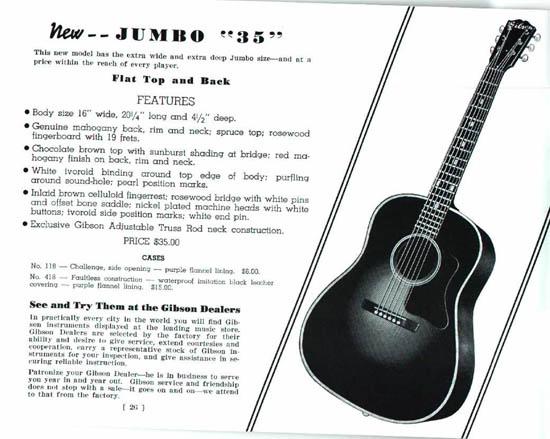
- Aug-Dec 1936 Gibson Trojan guitar introduction specs:
-
First listing in the Gibson ledger as "Trojan" is Oct 27, 1936 FON# 912b.
But this model was probably made earlier like Oct 15 and Aug 27, 1936 and listed as "new jumbo".
Last listing is Dec 17, 1936 for a Trojan. The J-35 appears in the ledgers on Dec 10, 1936.
Early Trojans have a deeper "non-tapered" body like the Gibson Jumbo
(16" wide, 20 1/4" long, 3 7/8" body depth at neck and 4 7/8" body depth at endpin,
3 3/4" hole diameter), but most Trojans have
a tapered J35 style body. For example dimensions on a Trojan are typically
4.5" body depth at end pin, 4.25" body depth at neck, and
3.75" sound hole diameter. Small French heel style neck heel
"V" neck, no neck binding, dot fingerboard inlays, 19 frets, truss rod.
Black peghead with white "Gibson" script logo.
Jumbos, Trojans, and early J35s used three tone bars and none were scallop braced.
All Trojans have a 3 3/4" sound hole (versus a J-35 which has a 4" soundhole.)
Firestripe pickguard and small Brazilian rosewood rectangle bridge and fingerboard.
with three tone bars, spruce top, mahogany back/sides/neck,
w/b/w soundhole rosette, single bound top, no back binding.
Gibson only made this model for a very very short time during August to
December of 1936, and only a few batches seemed to be made (FON 912, 918, 960B, 961B.)
This model name and specs morphed into the J-35, hence the change in body tapper.
The later batch numbers like 1023B, 1028B, 1032B, 1042B, 1071C, 1284C, 1323C, 78C, 91C, 124C, 377C, 442C, 459C, 466C, 877C
were all progressing away from Trojan specs and gradually towards J-35 specs
(1284c and later batches are clearly not Trojan specs.)
The other major difference between a J-35 and a Trojan is the the Trojan has no back body binding,
and the back is more of a redish mahogany color (instead of a brown mahogany like a J-35),
the J-35 has a tapered body thickness, and Trojans have a square neck block.
- December 1936 Gibson Jumbo 35 (J-35) guitar introduction specs:
- $35 retail list price, 16" wide, round
shoulder dreadnought shape, dark red finished mahogany back and sides, three-on-a-plate
plastic button tuners (often Kluson), single bound top, no back binding, no neck binding,
4" soundhole, usually 3 tone bars, tapered body (as looking from the sides),
rectangle bridge with two tiny bridge screws (and hence two pearl dots),
top braces not scalloped (usually), "X" bracing with three tone bars, "V" shaped mahogany neck,
usually small pointy French neck heel, 24.75" scale length,
dot fingerboard inlays, rosewood fingerboard,
white silkscreened peghead "Gibson" logo, "medium" sized
sunburst top, deep red mahogany back and side finish.
Bracing is usually three nonscalloped tonebars (a character of between the Jumbo
and J-35 first issue).
- 1937 Gibson Jumbo 35 J-35 guitar specs:
- back binding added, some models
seen with scalloped top braces, "large" size top sunburst finish, $37.50 retail list price.
By 1937 usually (but not always)
the bridge has clear lacquer over the rosewood base. Gibson glued the bridge
to the guitar's top when the body was assembled and before painting - this saved the step of
scraping lacquer around the bridge area and gluing after the guitar was painted.
This step was a minor cost/time saving measure. Note not every J-35 has a clearcoated
bridge, but most do.
Bracing is now 'regular' first issue with three nonscalloped tonebars (the unique and
typical J-35 sound with an excellent response and clear but woody sound.) This bracing is
used until about 1939.
- 1938 Gibson Jumbo 35 J-35 guitar specs:
-
usually rounded (J-45 style) neck heel, sometimes just two scalloped tone bars.
- 1939 Gibson Jumbo 35 J35 guitar specs:
- neck shape rounded and not "V",
the small french heel is now rounded instead of pointy,
neck back shape transitions from "V" to round,
"X" bracing changed and moved closer to the soundhole and two non-scalloped tone bars,
available in natural finish (back, sides and neck are usually a chocolate brown
color on the natural colored models). Also seen is a "Cremona" sunburst, which has
a lighter chocolate brown in the dark part of the sunburst (instead of darker brown/black).
Sometimes a "stacked heel" design is seen on the neck heel too (where the heel is
two distinct pieces of wood). This saved wood when cutting the necks. This technique
was seen more in 1941/1942 as the war was effecting wood supplies (but the "stacked heel"
is not the norm for J-35, and is somewhat rare).
Bracing changed from three to two nonscalloped tonebars during 1939 (fuller and more dynamic sound with clearer and
higher treble, fuller bass, not the same response as the first issue but still clear and crisp.)
This bracing was generally used in 1939 and 1940.
- 1940 Gibson Jumbo 35 J35 guitar specs:
- transition from round neck heel back to small pointy French heel.
Nut goes from white to black ebony.
- 1941 Gibson Jumbo 35 J35 guitar specs:
- sunburst or natural finish available.
Some "drop in" saddle bridges are seen in 1941 and 1942 (opposed to the longer
slide-in saddle). Also in 1941 the string spacing on the bridge started to narrowed a bit.
Most natural finish J-35 models now have a more "clear" back/sides
finish, and is less chocolate brown.
Bracing now two scalloped tonebars (open, dynamic and more boomy sound, louder trebles,
the biggest sounding model of all J-35's). This bracing was generally used in 1941 and 1942,
and is the same style used on the new J-45 models.
$40 list price for sunburst, $45 list price for natural, which was changed to
$42 list price for sunburst and $47.25 for natural, in late 1941.
- 1942 Gibson Jumbo 35 J35 guitar specs:
- In late 1941 or early 1942 Gibson experimented with an opaque finish.
It looks very similar to a natural finish, but the grain of the wood isn't
nearly as obvious.
- Gibson J-35 guitar discontinued late 1942 and replaced by the J-45.
Late 1941-1942 Gibson natural versus blond opaque finish.
